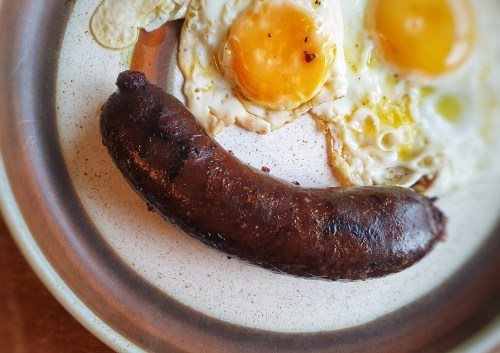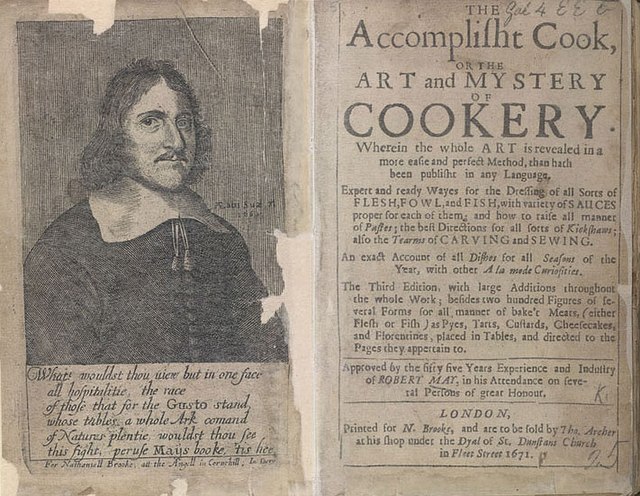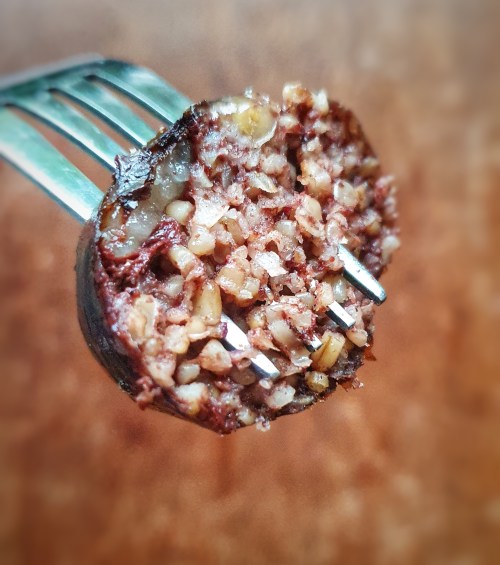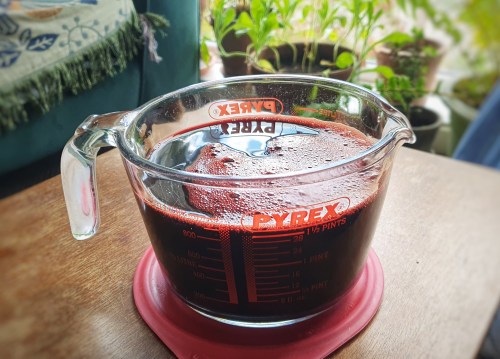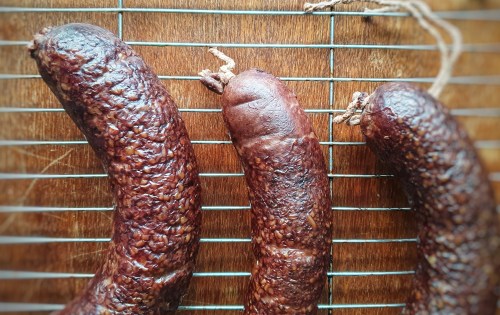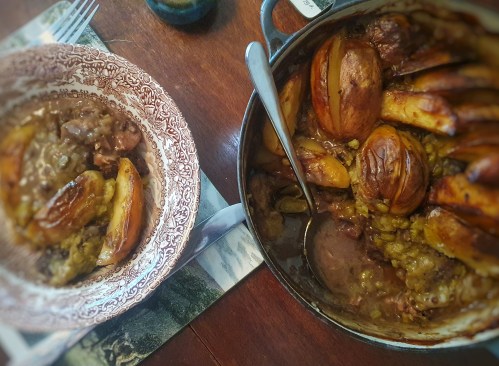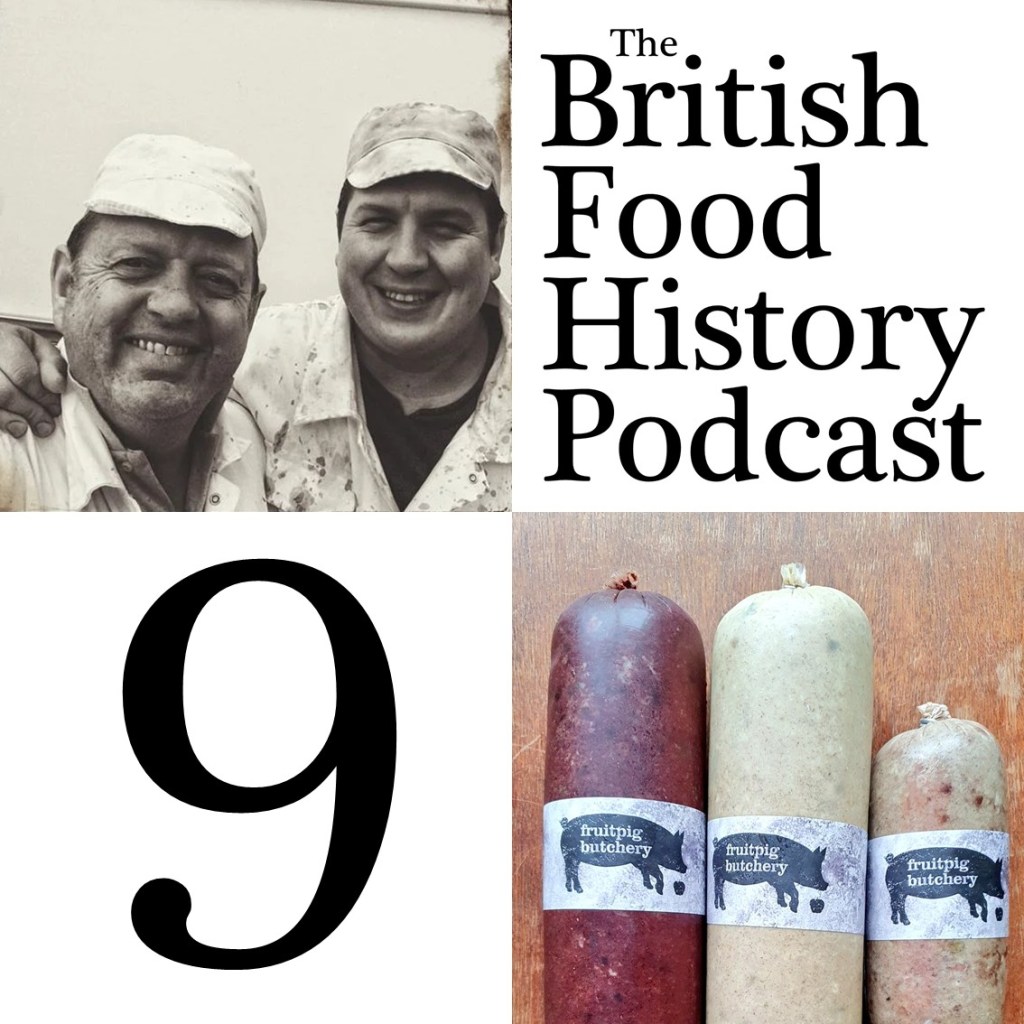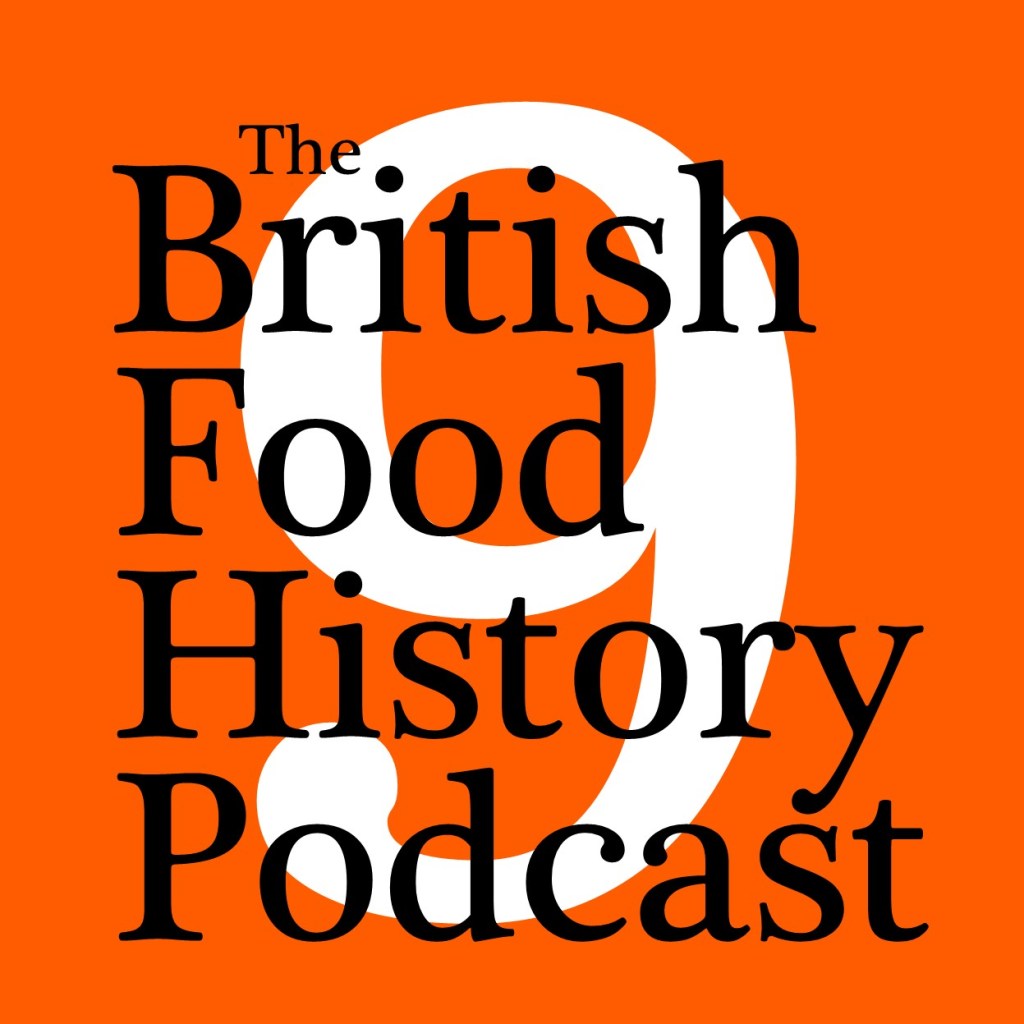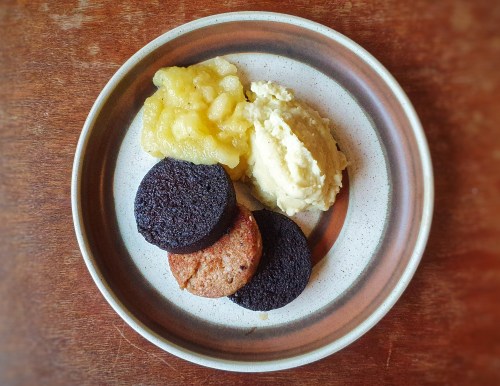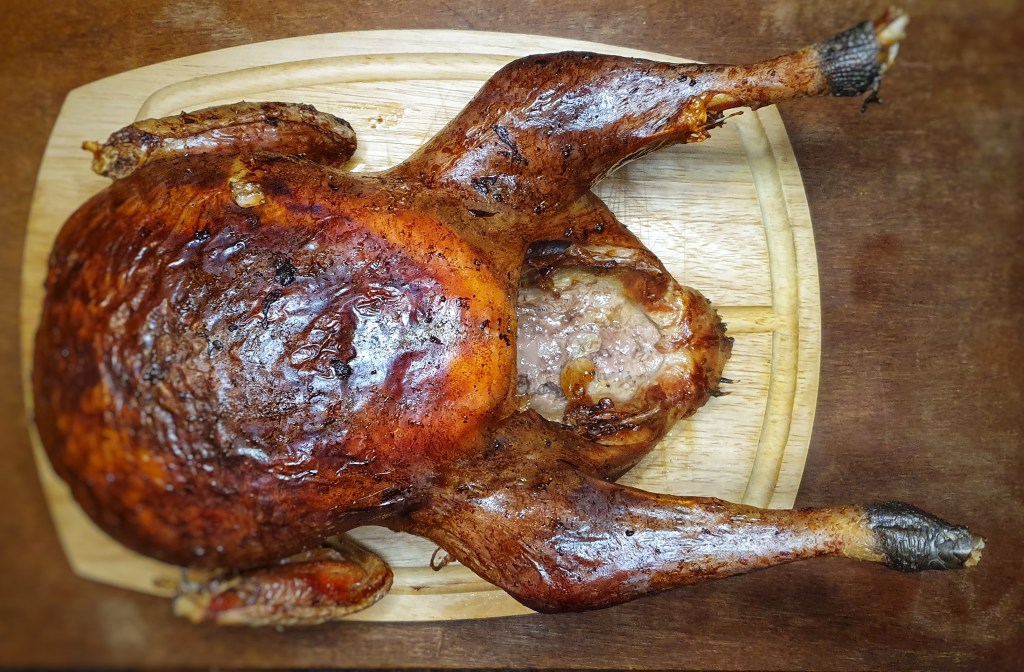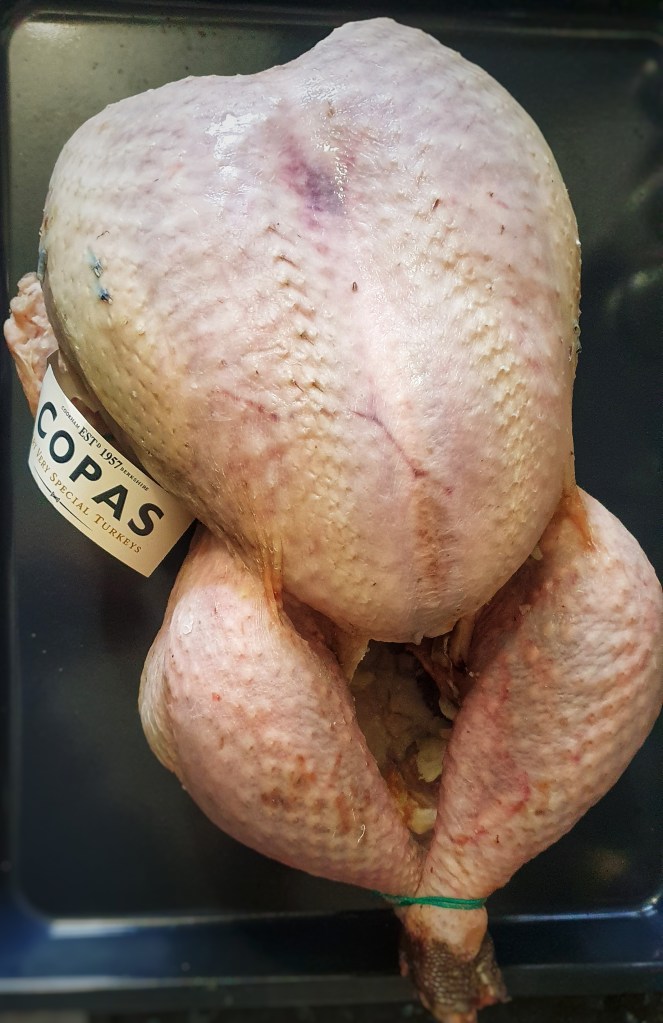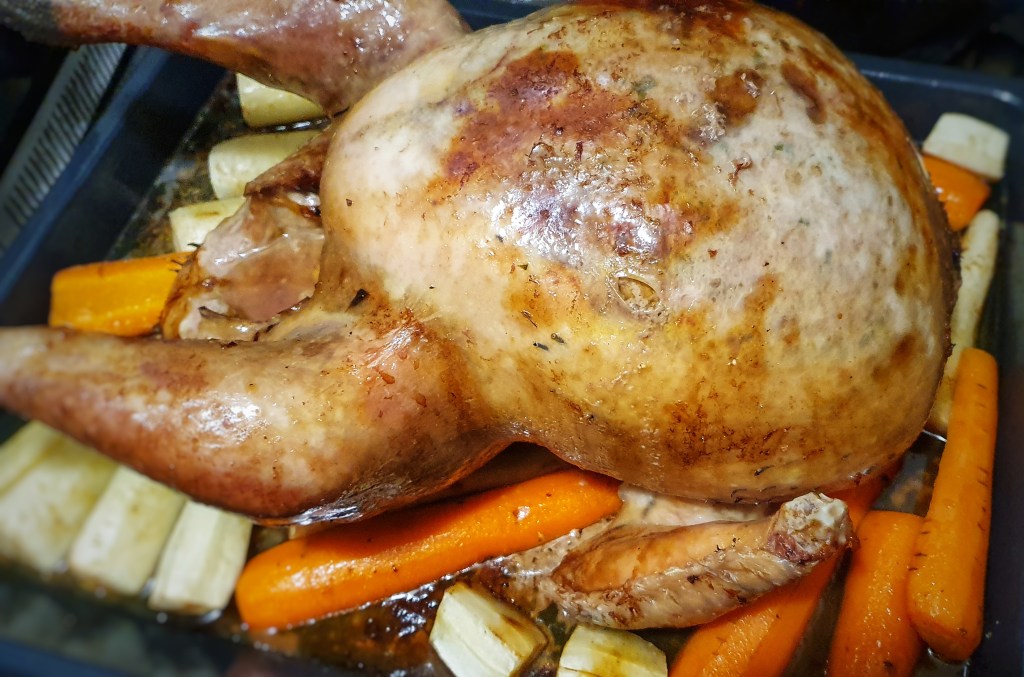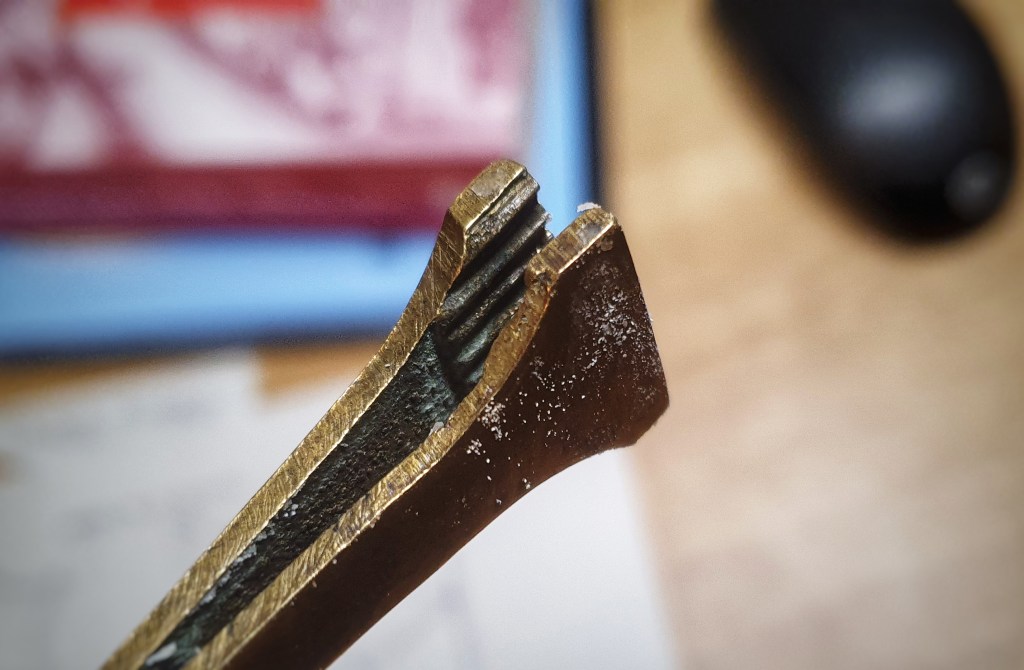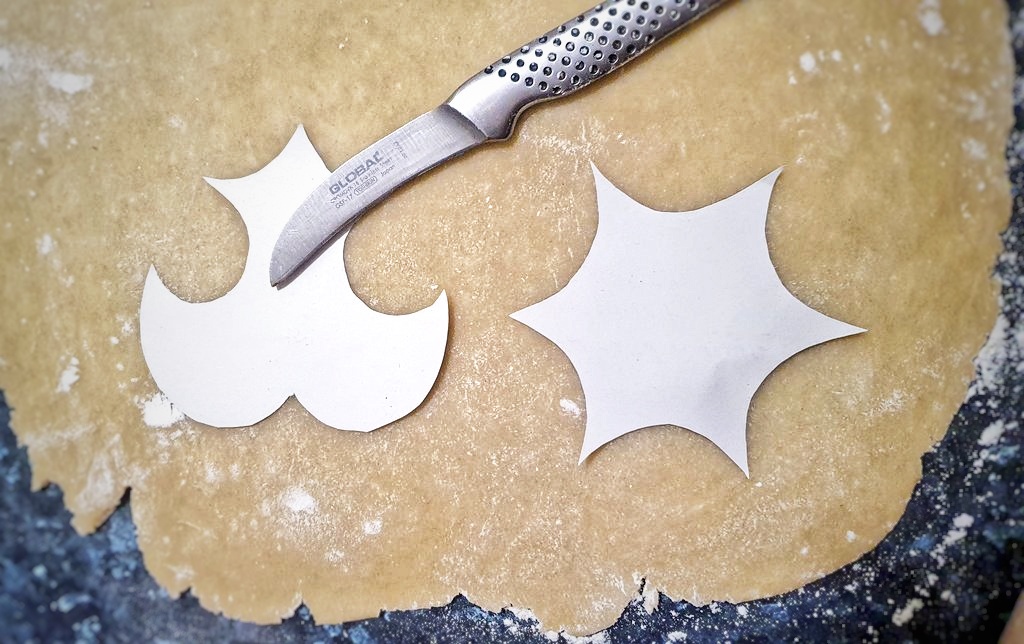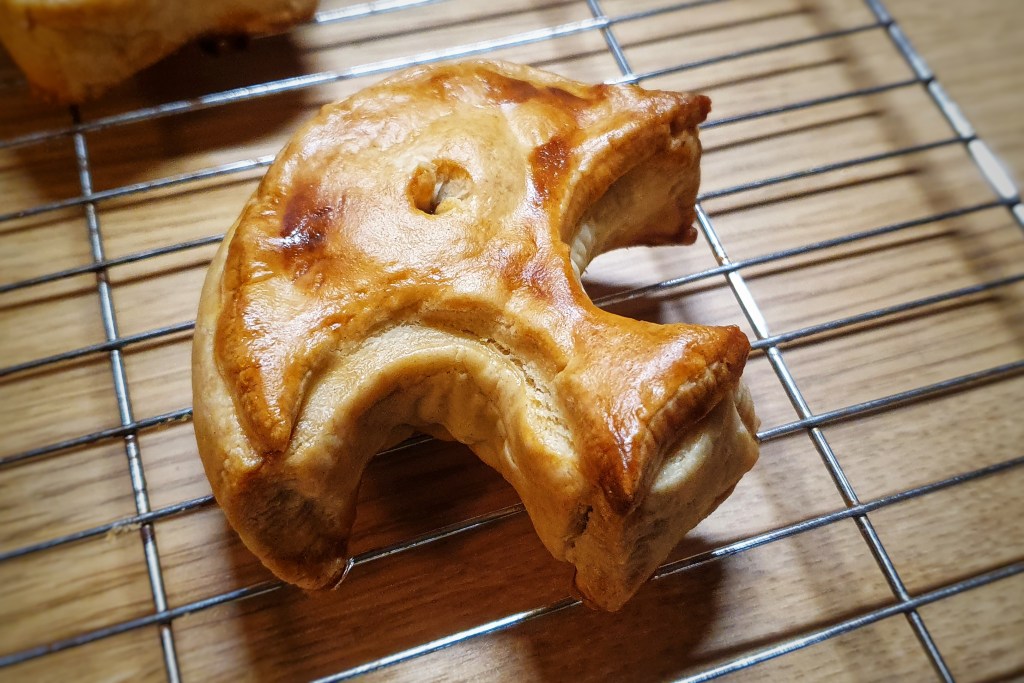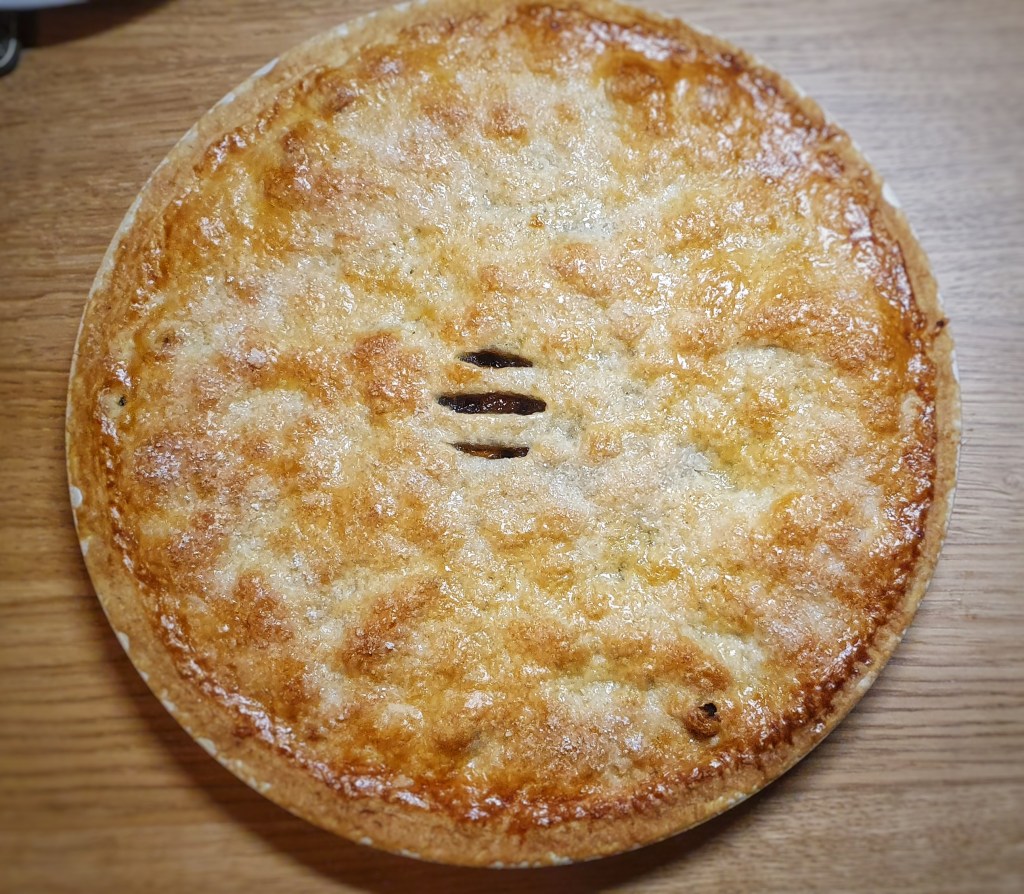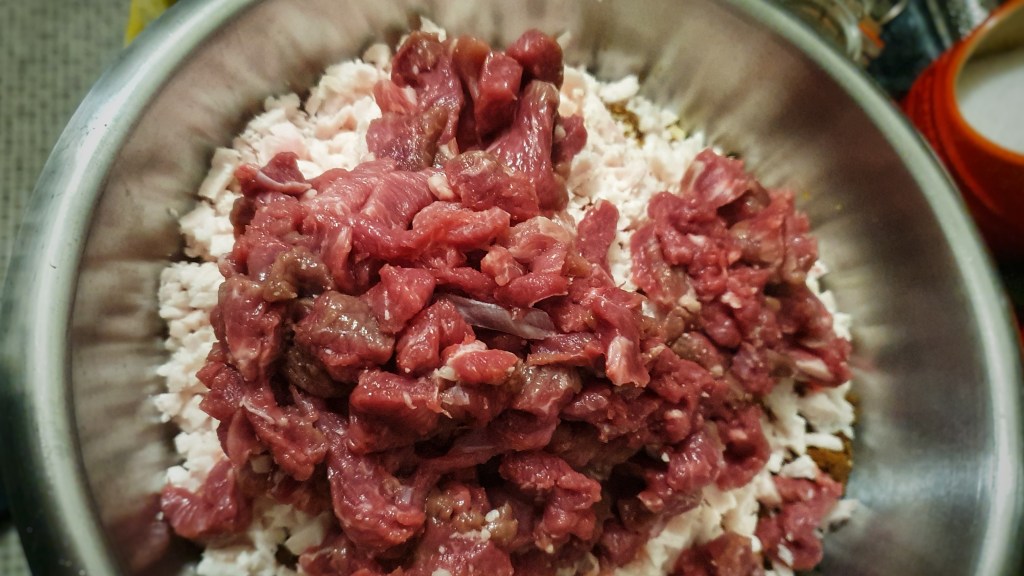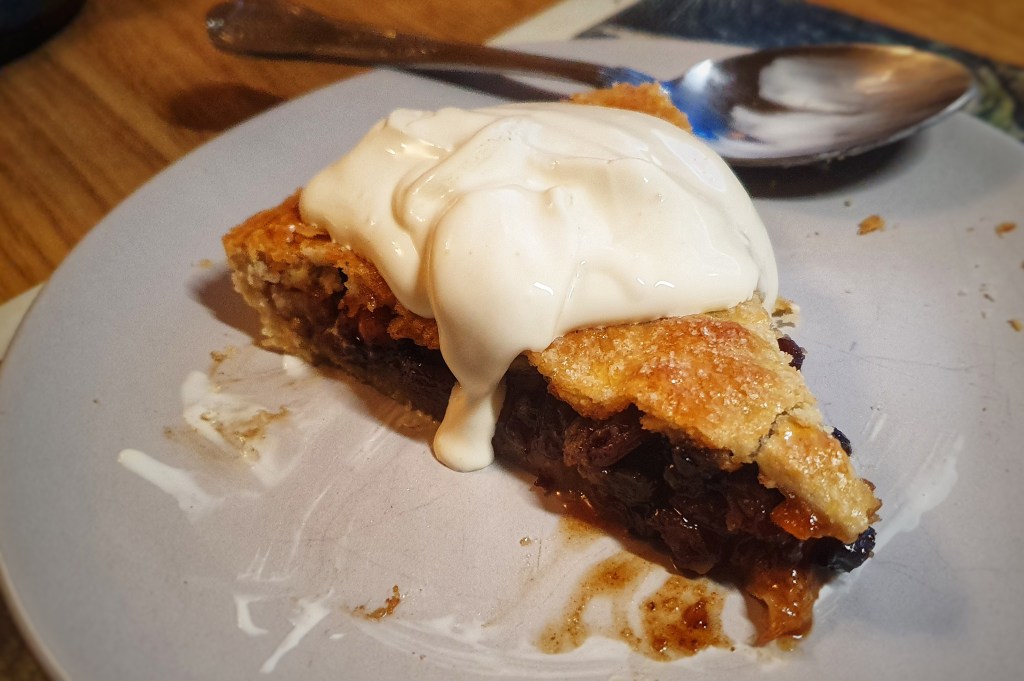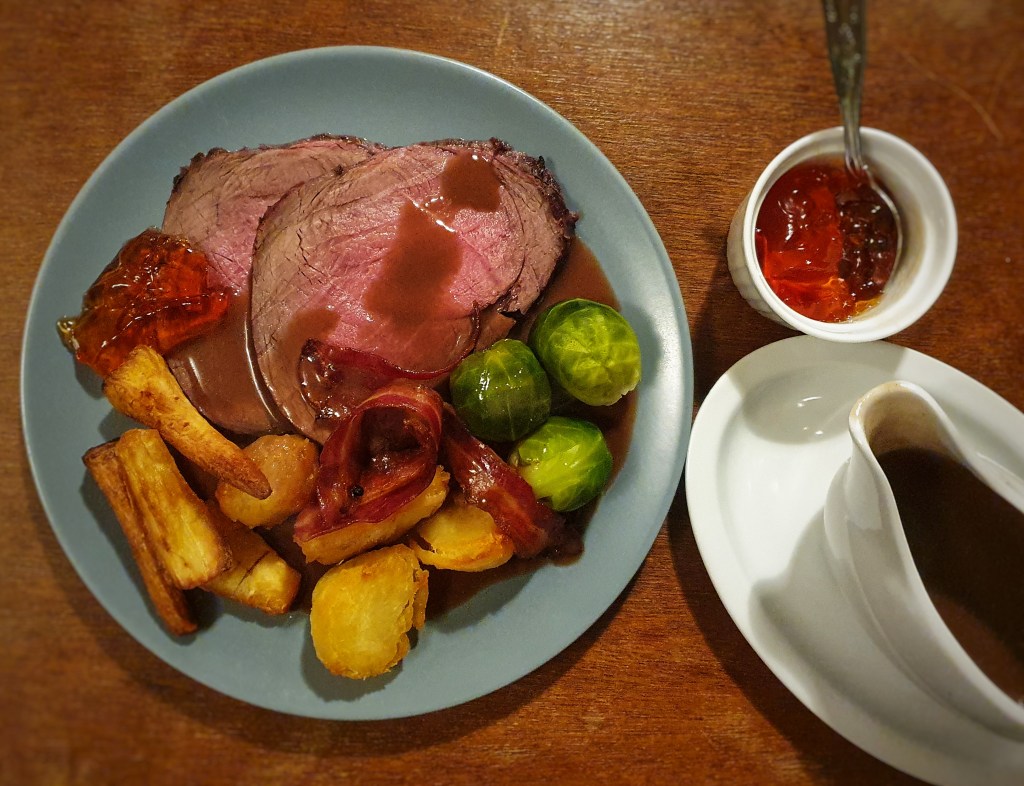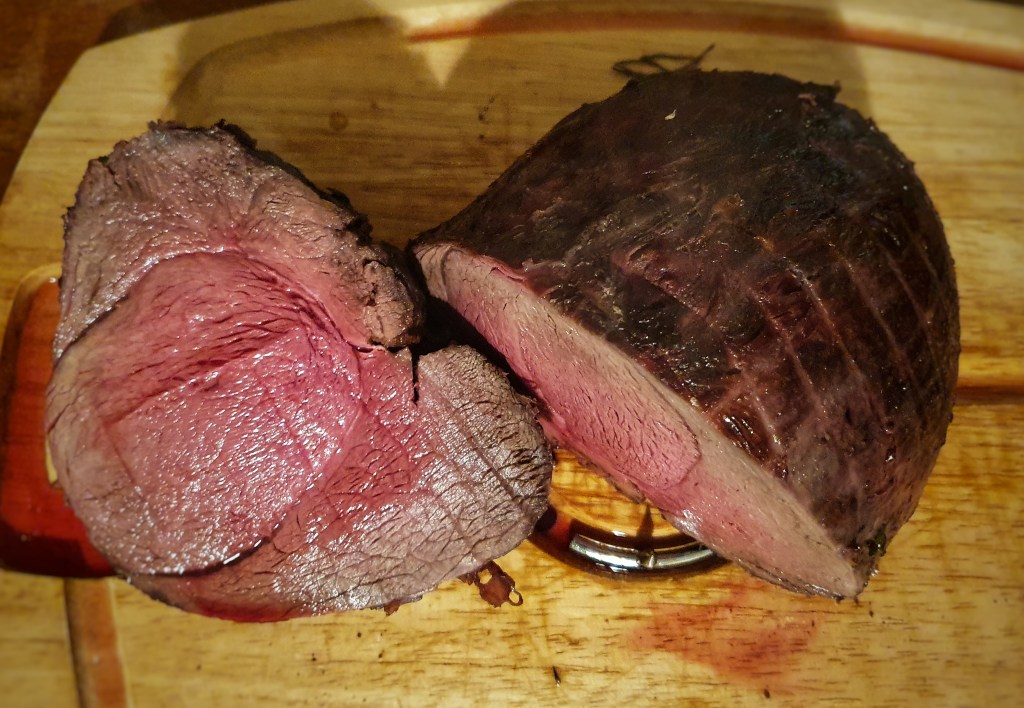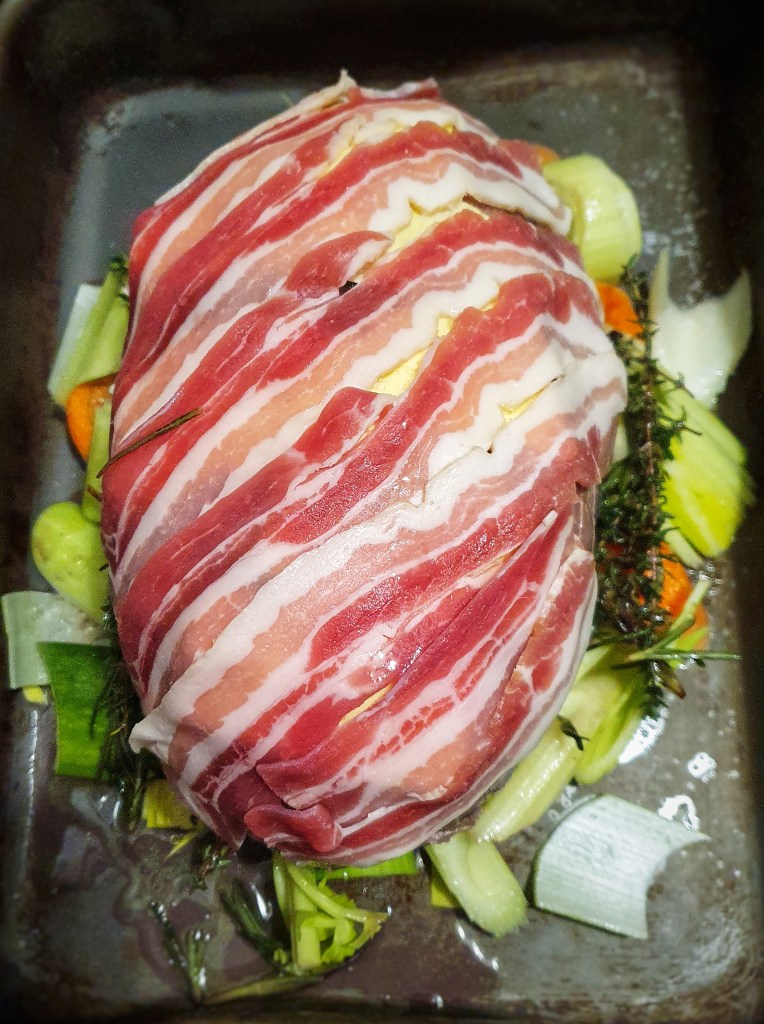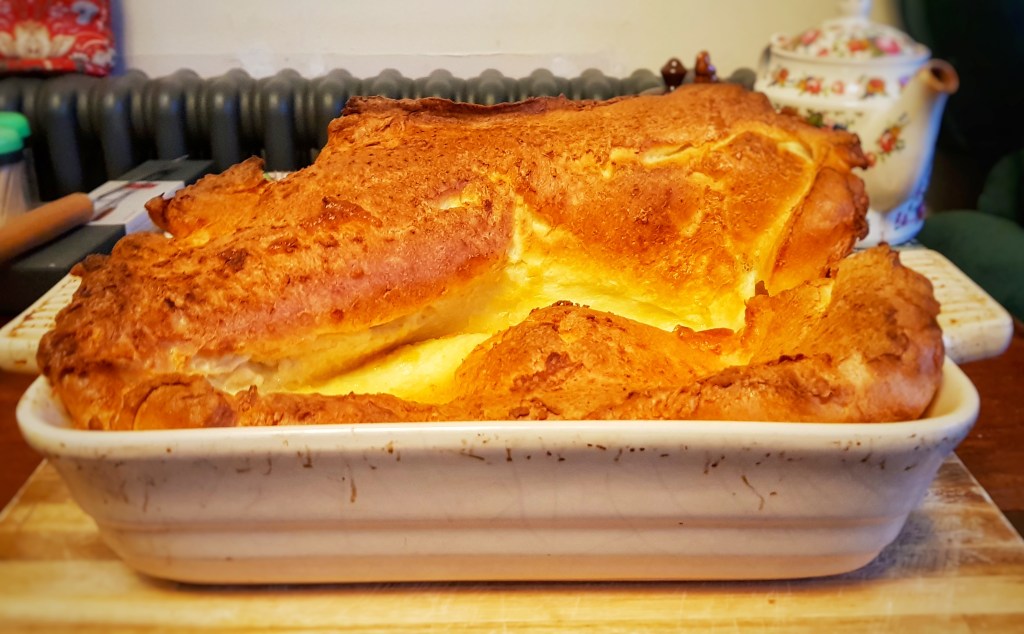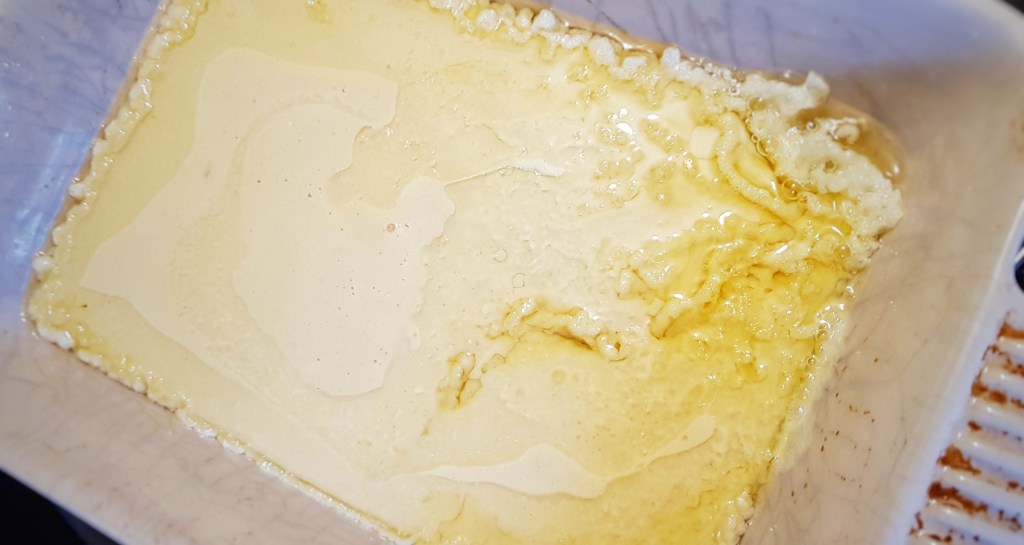Hello! I thought some of you might be interested in a post I just published on the other blog, Neil Cooks Grigson.
Tag Archives: meat
A Recipe for Early Modern Black Puddings
For years now, I have wanted to make my own fresh blood black puddings, but fresh blood is so tricky to get hold of in Britain, I thought I would never get the opportunity. Lucky for me then, that Fruit Pig, who are sponsoring the ninth season of The British Food History Podcast, kindly sent me a litre of pig’s blood. When it came to recipes, I very much had my eye on Early Modern black puddings because they seem so outlandish compared to traditional black puddings of today. On one hand, they are very British, containing oatmeal and/or breadcrumbs and plenty of chopped beef suet. On the other, they are reminiscent of a French boudin noir in that there are lashings of cream and egg yolks.
There are lots of unexpected herbs and spices, too. Thomas Dawson uses sheep’s blood, milk-soaked oats, suet and what we might think of as the constituents of a mixed spice today: nutmeg, mace, black pepper, ginger and cinnamon.[1] Sir Kenelm Digby liked to use chicken blood, cream, almond cream, bone marrow, sugar, salt, rosewater and eggs.[2] Robert May gives us some precise pointers as well as several ways of making black puddings. In one recipe he combines blood and cream in a ratio of 2:1. Sometimes he soaks oats in milk, sometimes blood: ‘Steep great oatmeal in eight pints of warm goose blood, sheeps blood, calves, or lambs, or fawns blood’. He uses a whole range of interesting herbs, including thyme, spinach, parsley, sorrel and strawberry leaves, to name but a few. He also adds ‘Sometimes for variety, Sugar, Currans, &c.’[3] I really want to know what sweet black pudding tastes like!
Using these descriptions as inspiration, I created the recipe below. There was a certain amount of trial-and-error, and whenever I got stuck, I made sure to gain advice from Regula Ysewijn’s Pride and Pudding, Hugh Fearnley-Whittingstall’s The River Cottage Cookbook and Fergus Henderson’s The Complete Nose to Tail.[4]
I learned a great deal making them – the most important lesson being just how skilled one must be to make these sorts of puddings frequently and in large amounts. It made me appreciate even more the hard work of our forebears and Fruit Pig!
I was really surprised with how well the puddings turned out, and I would certainly recommend giving them a go. I made one batch with sugar and currants and one without. You might be surprised to hear that the sweet one was really quite delicious. I fried my savoury puddings and served them with fried eggs atop some sourdough toast. They tasted rich and were a cross between a black pudding and haggis. I’ll let you know how I served the sweet black puddings.
There are just a couple of things I would have done differently: my main issue was that the butcher gave me pigs’ casings which were not suitable for these black puddings – the nubbly pieces of oat tore through them easily, and the skin burst under their own weight at times. I would therefore recommend beef casings or simply baking them in the oven in loaf tins, or maybe even frying up blood pancakes as suggested by Regula Ysewijn![5]
If you can, support the podcast and blogs by becoming a £3 monthly subscriber, and unlock lots of premium content, including bonus blog posts and recipes, access to the easter eggs and the secret podcast, or treat me to a one-off virtual pint or coffee: click here.
Recipe
Makes approximately 12 x 20 cm black puddings if made in pork casings, and 6 x 20 cm puddings if made in beef casings.
600 g pinhead oats
Milk (see recipe)
1 tsp fennel seeds
½ tsp cloves
½ tsp black peppercorns
3 blades of mace
1 ½ tsp dried, mixed herbs
2 tsp salt
900 ml fresh pig’s blood (or reconstituted dried blood)
600 ml double cream
200 g chopped beef suet
2 whole eggs, beaten
140 g currants (optional)
320 g sugar (optional)
Natural pork or beef skins, soaked in water overnight (optional, see recipe)
The day before you want to make your puddings, place the oats in a bowl or large jug and pour in enough milk to just cover them. Place in the fridge overnight. Grind the spices and mix in the dried herbs and salt.
Next day, place all of the ingredients (aside from the casings, if using) in a large mixing bowl. Combine and allow everything to mingle, dissolve and absorb; around an hour – or more if you have the time.[6]

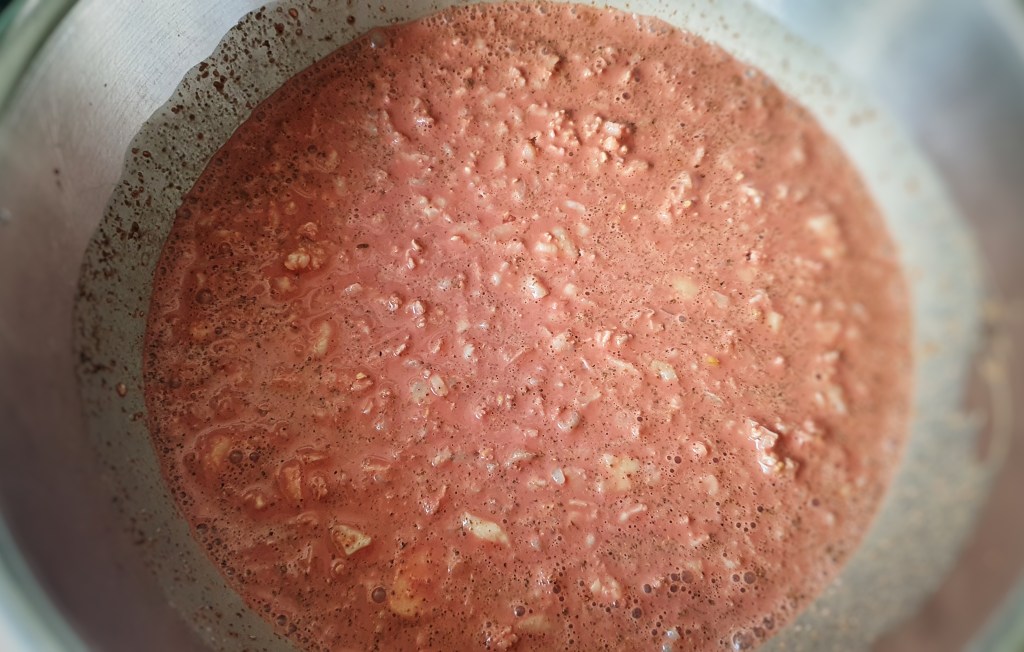

Once everything has had the chance to macerate and absorb, it is time to assemble the puddings. I used my sausage stuffer funnel from the Kitchen Aid and attached a length of pork casing onto it, then secured it with some string and knotted the end. Then I set about filling the casings, a spoon at a time, letting the skins naturally fill and fall into a bowl. Then I tied a link off with some string, making sure the casing wasn’t full and there were no obvious air bubbles. The lengths of the puddings were around 20 cm – though I wasn’t very consistent. In retrospect, I would recommend using beef casings tied to a wide-mouthed jam funnel, much easier to fill and no constant tearing.
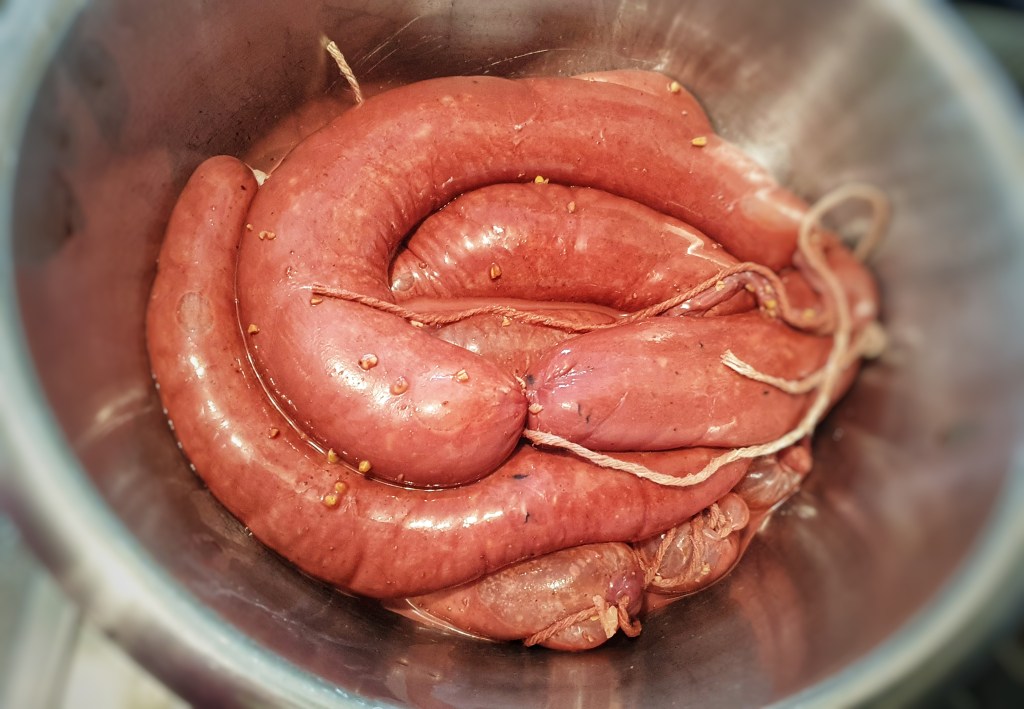
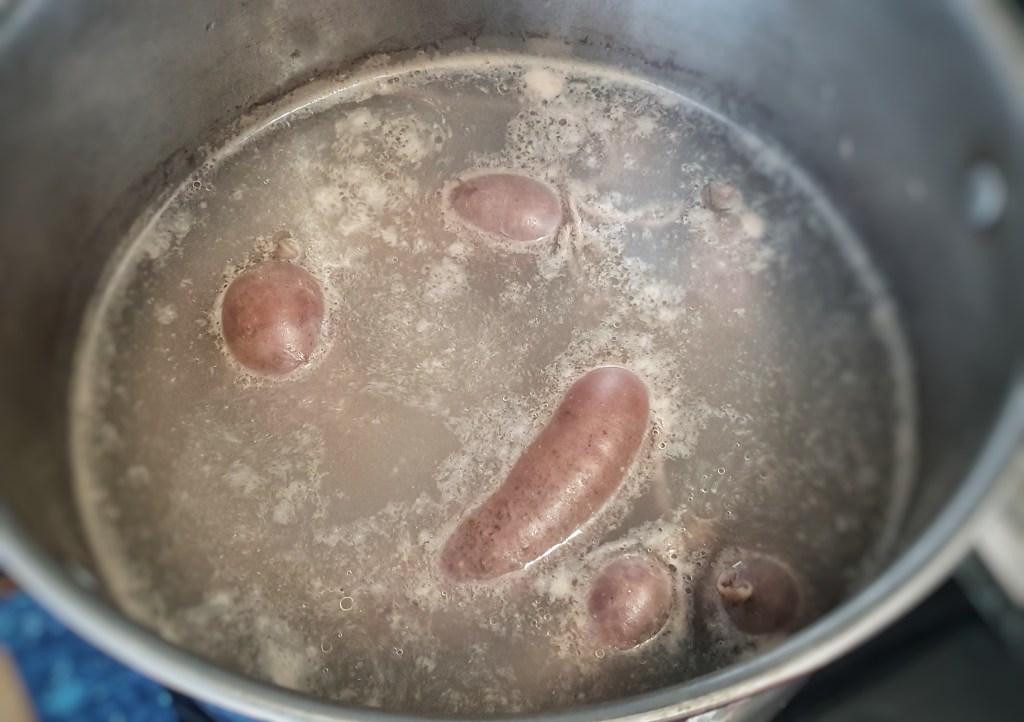
Once all of the mixture is used up, get a large pot of water to a good simmer and gingerly plop them in a few at a time. Three was a good number. Keep the water at a gentle simmer and arm yourself with a pin and pop any bubbles that appear in the cooking puds, lest they burst. They will take around 20 minutes to cook, and you must watch them like a hawk, pin poised and ready to pop. You can tell they are done when the liquid that comes out of a freshly-pricked pudding is clear. If using beef casings, they will take 30 to 35 minutes to cook.
Carefully remove the puddings and either hang them up or lay them on a cooling rack to dry for a few hours before placing them in the refrigerator.
You can avoid all of this faff by baking the mixture in large loaf tins sat in a bain-marie for around 1½ hours at 160°C.[7]
Notes
[1] Dawson, T. (1596). The Good Housewife’s Jewel (1996 Edition). Southover Press.
[2] Digby, K. (1669). The Closet of Sir Kenelm Digby Opened (1997 reprint) (J. Stevenson & P. Davidson, Eds.). Prospect Books.
[3] May, R. (2012). The Accomplisht Cook (1660/85) (A. Davidson, M. Bell, & T. Jaine, Eds.; 1685th ed.). Prospect Books.
[4] Fearnley-Whittingstall, H. (2001). The River Cottage Cookbook. Collins; Henderson, F. (2012). The Complete Nose to Tail: A Kind of British Cooking. Bloomsbury; Ysewijn, R. (2015). Pride and Pudding: The History of British Puddings Savoury and Sweet. Murdoch Books.
[5] Ysewijn (2015)
[6] Note: Looking back on these initial stages, it would have been much better to soak the oats in the blood overnight, mix everything together in the morning, let everything meld and mingle for a couple of hours, and then add enough milk to make a mixture of a spoonable porridge consistency. We live and learn.
[7] Note: I haven’t tested this method; these instructions have been extrapolated from the Fergus Henderson recipe for blood cake in Henderson (2012).
Cumbrian Tatie Pot (aka Cumberland or Westmorland Hotpot)
In my last post I launched the ninth season of The British Food History Podcast with an episode about Black and White Pudding with Matthew Cockin and Grant Harper (aka Fruit Pig). Not only are they the only remaining craft producer of fresh blood black puddings in Britain, but they are very kindly sponsoring this season of the podcast. Their puddings are exceptional, and Matthew and Grant are very kindly giving readers of the blog and listeners of the podcast 10% off at their online shop (www.fruitpig.co.uk) with the offer code Foodhis, so if you can please support them – if we don’t use producers like Fruit Pig, we will lose them, and that would be a terrible shame. It’s also worth checking with your local butcher – my nearest traditional butcher, Littlewood’s in Heaton Moor, Stockport, the very place where I bought the meat for today’s recipe, stock them – so perhaps yours does too (or you could suggest they do if they don’t!). Have a listen to the episode, if you haven’t already:
Now, I reckon the vast majority of black pudding eaters enjoy theirs as part of a fried breakfast, but I think we need to remember that black puddings can be eaten for any meal, and in the last post I detailed the old traditional way of eating them with mashed potato and apple sauce. Today I am going one better with this delicious and warming Cumbrian Tatie Pot, a hotpot made of lamb, beef and black pudding, pulses and onions, topped not with nice, neat round slices of potato like a Lancashire hotpot, but quartered floury potatoes.[1] It is important that the cheaper, tougher cuts of beef shin and lamb neck are used, and that the hotpot should be cooked long and slow.
The result is a rich and unctuous hotpot that sticks to your ribs and serves plenty of people; it was on the menu at The Buttery in the first year it was open, and it was very popular.[2] Well-flavoured meat cuts like shin and neck require a similarly good-flavoured black pudding like those made by Fruit Pig.
I first heard about this rather decadent one-pot dish from Jane Grigson in her book English Food.[3] I can find only a few other references to it – a regional dish that seems to be rarely cooked today, yet should, in my opinion, be much more popular than it is.
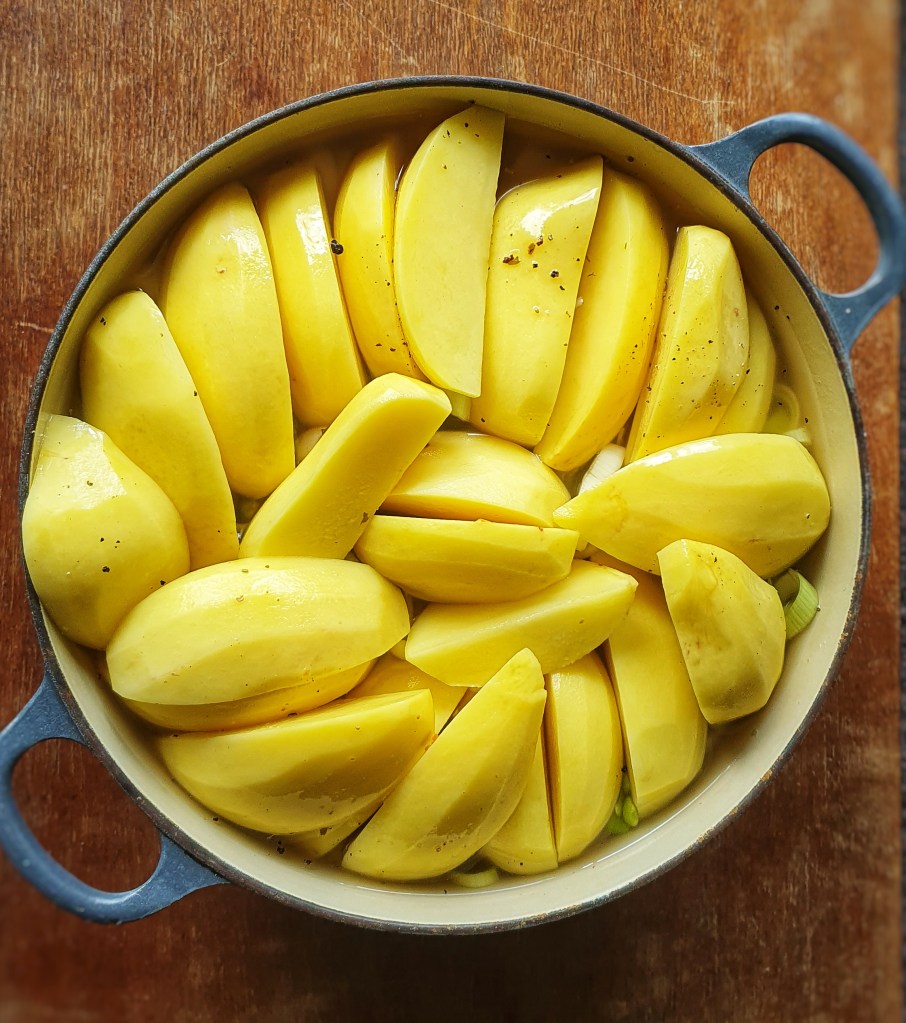
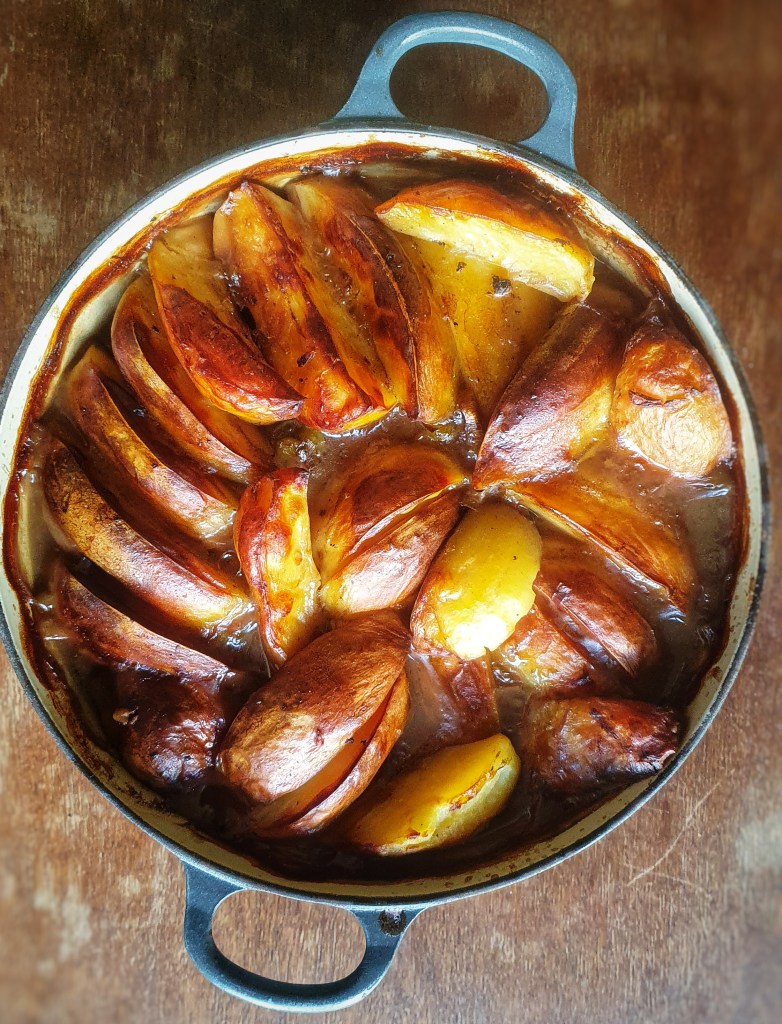
Jane was given the recipe from a Mrs Burrows, and in English Food, she tells us that ‘Mrs Burrows said that what interested her was that the tatie pot is one of our few dishes in which different meats are combined, something which is common in mainland Europe.’ Indeed, and assuming your black pudding contains pigs’ blood, then we have three species of mammal altogether; very rare indeed!
Jane Grigson points out that some recipes say that the beef is optional, ‘which it most definitely is not’, she writes, ‘[i]t makes the character of the dish.’ Looking at similar Lakeland recipes available on the Foods of England Project website, there are recipes that contain beef but not lamb (Westmorland tatie pot), and lamb but not beef (Cumberland hotpot). Neither contain pulses, and both have sliced potatoes nicely arranged on top like a Lancashire hotpot.[4] I’m not saying that Jane’s is right and others wrong; it is just interesting to me that everyone has their own correct version of a dish, possibly with slight geographical differences, and usually it’s the one you grew up with, the one that is most familiar to you, that is the ‘right’ one.
If you can, support the podcast and blogs by becoming a £3 monthly subscriber, and unlock lots of premium content, including bonus blog posts and recipes, access to the easter eggs and the secret podcast, or treat me to a one-off virtual pint or coffee: click here.
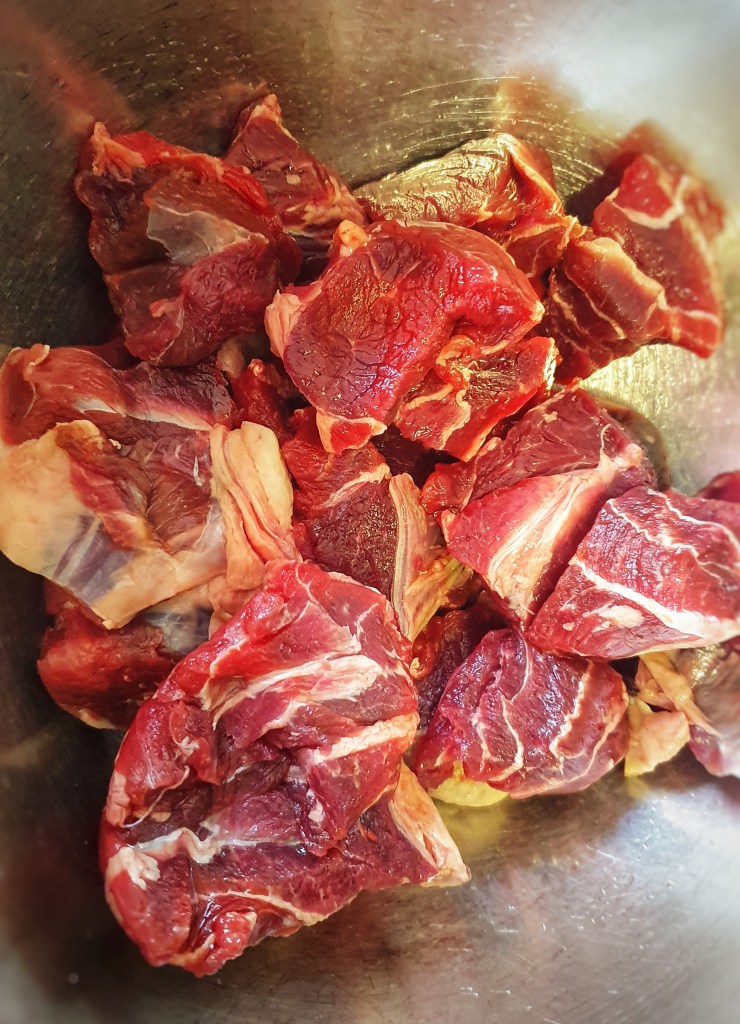

Recipe
The long cook time on this hotpot means that you need to keep the liquid levels topped up. You can use stock or water for this – there is nothing wrong with the latter when cooking with these robust cuts of meat.
Serves 8
4 tbs dried split peas or mixed pulses
750 g shin of beef
750 g lamb neck (‘scrag end’ of neck)
1 level tablespoon of cornflour
Salt and pepper
One 350 g Fruit Pig black pudding
2 onions, peeled and sliced, or 2 leeks, trimmed, rinsed and thinly sliced
Around 1.2 kg floury potatoes
Around 800 ml hot light beef, lamb, or chicken stock, or water
Soak the pulses in water overnight (or, if you are badly organised, soak in warm water for 4 or 5 hours).
Preheat your oven to 160°C. Shake the meat, cut into neat chunks, with the cornflour, and scatter the pieces over the base of a large casserole, season with salt and pepper, then tuck in slices of the black pudding. Sprinkle with the onions or leeks and the drained pulses. Peel the potatoes and slice them into quarters lengthways. Arrange the quarters on top; I find it is impossible to do this neatly. Pour over enough stock to go halfway up the potatoes and season them with more salt and pepper.
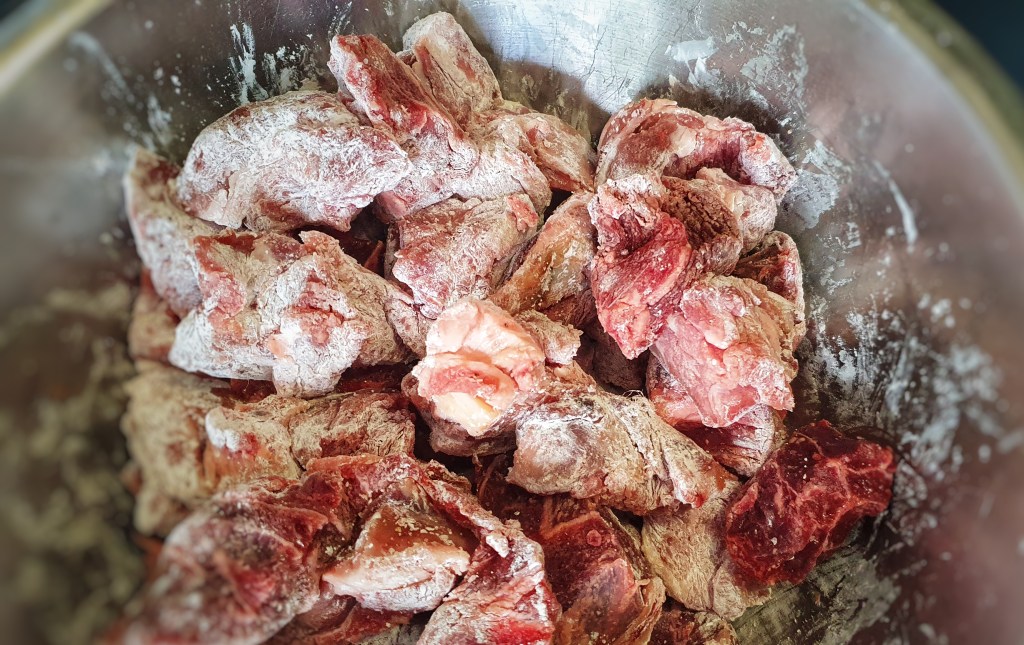
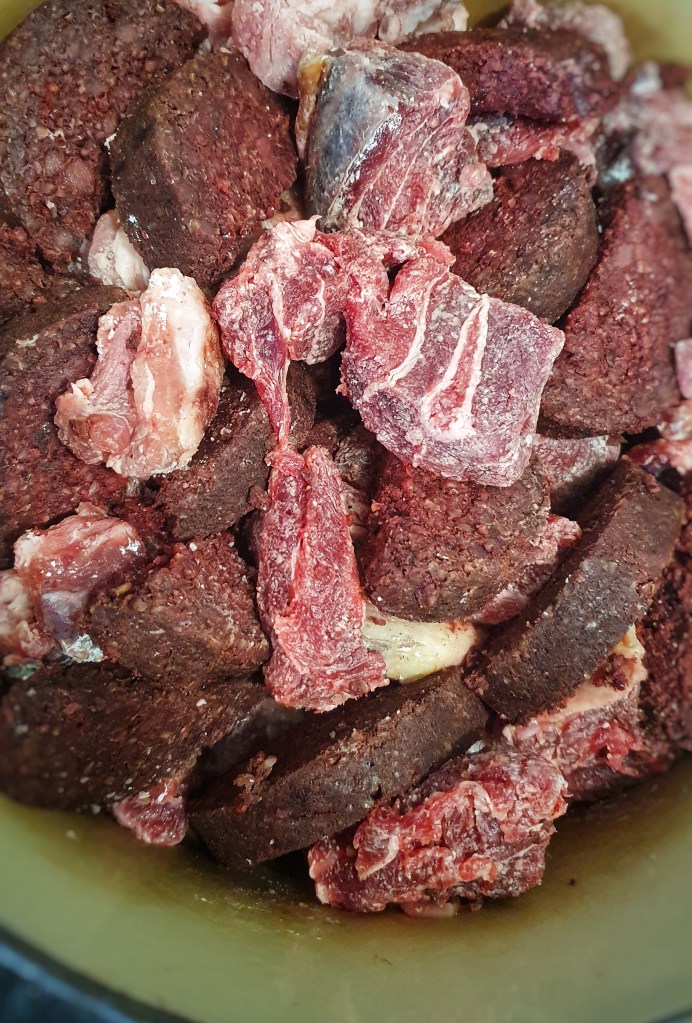
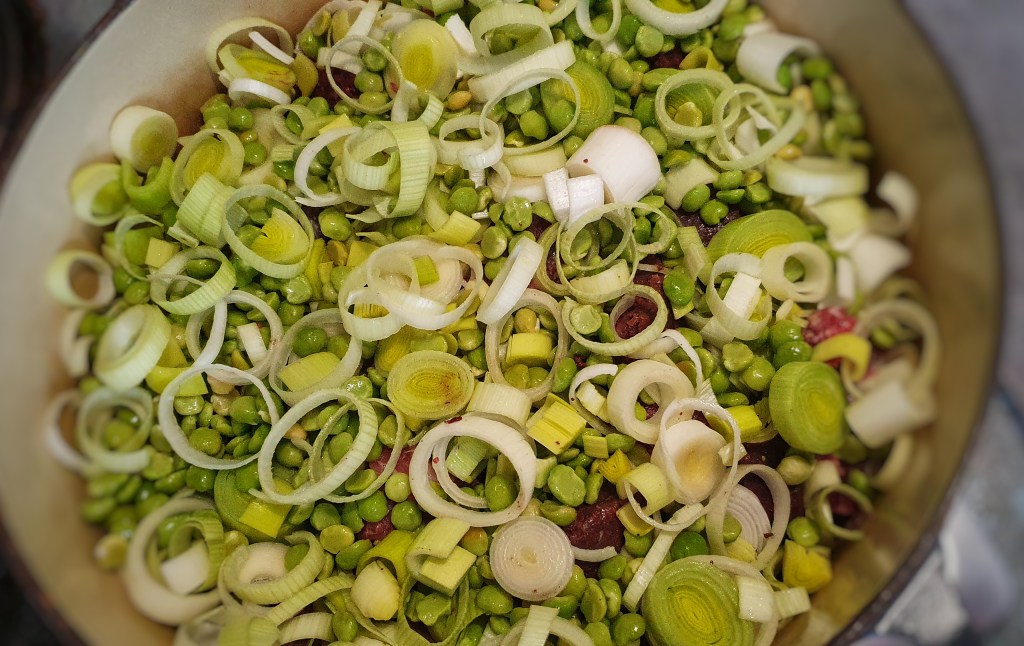
Bake for 4 hours, topping up with more stock or water every hour or so.
Serve with steamed green vegetables or braised red cabbage.
Notes:
[1] Grigson, J. (1992). English Food (Third Edit). Penguin.
[2] The Buttery was my bricks-and-mortar restaurant in Levenshulme, Manchester, open between 2016 and 2017, though it did exist as a pop up restaurant and artisan market stall before that.
[3] For those not in the know, I got into this traditional cookery and food history malarky because I cooked every recipe (well, almost every recipe) in Jane’s wonderful book. This was my first blog Neil Cooks Grigson. Hear about it in this podcast episode from season 8:
[4] Hughes, G. Tatie Pot. The Foods of England Project; https://foodsofengland.info/tatiepotorcumberlandhotpot.html.
Black & White Pudding with Matthew Cockin & Grant Harper
Welcome to the first episode of season 9 of The British Food History Podcast! I am going to be adding a blog post to complement each new episode of the podcast, to help readers of the blog keep tabs on what is going on.
Today I am talking with Matthew Cockin and Grant Harper of Fruit Pig – the last remaining commercial craft producer of fresh blood black puddings in the UK.
Fruit Pig are sponsoring the 9th season of the podcast and Grant and Matthew are very kindly giving listeners to the podcast a unique special offer 10% off your order until the end of October 2025 – use the offer code Foodhis in the checkout at their online shop, www.fruitpig.co.uk.
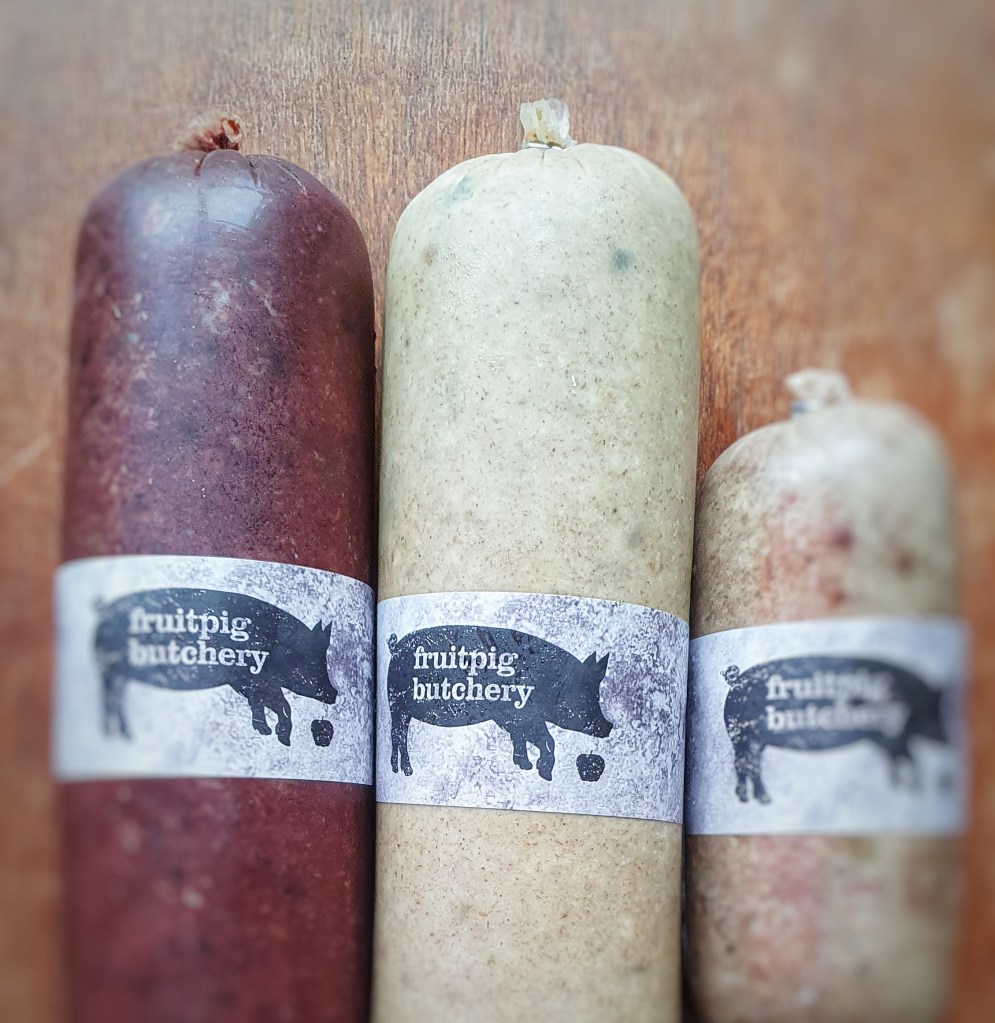
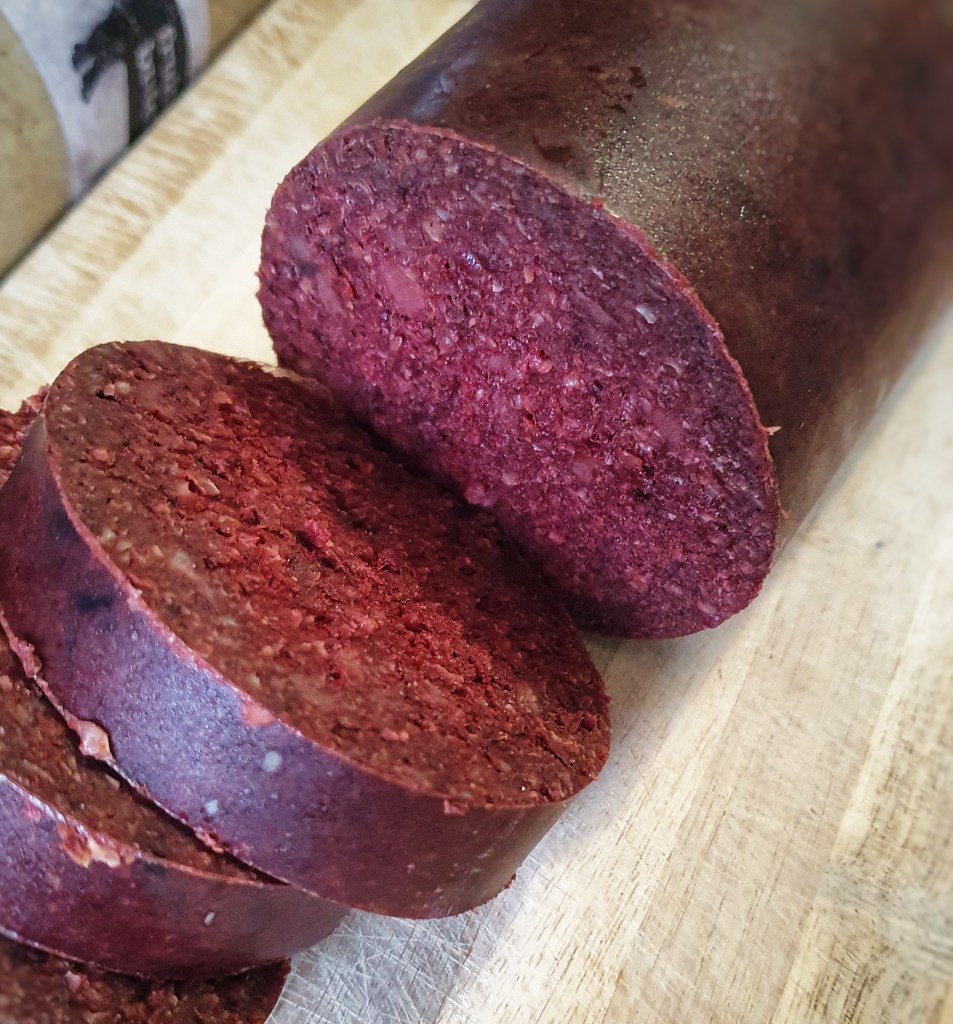
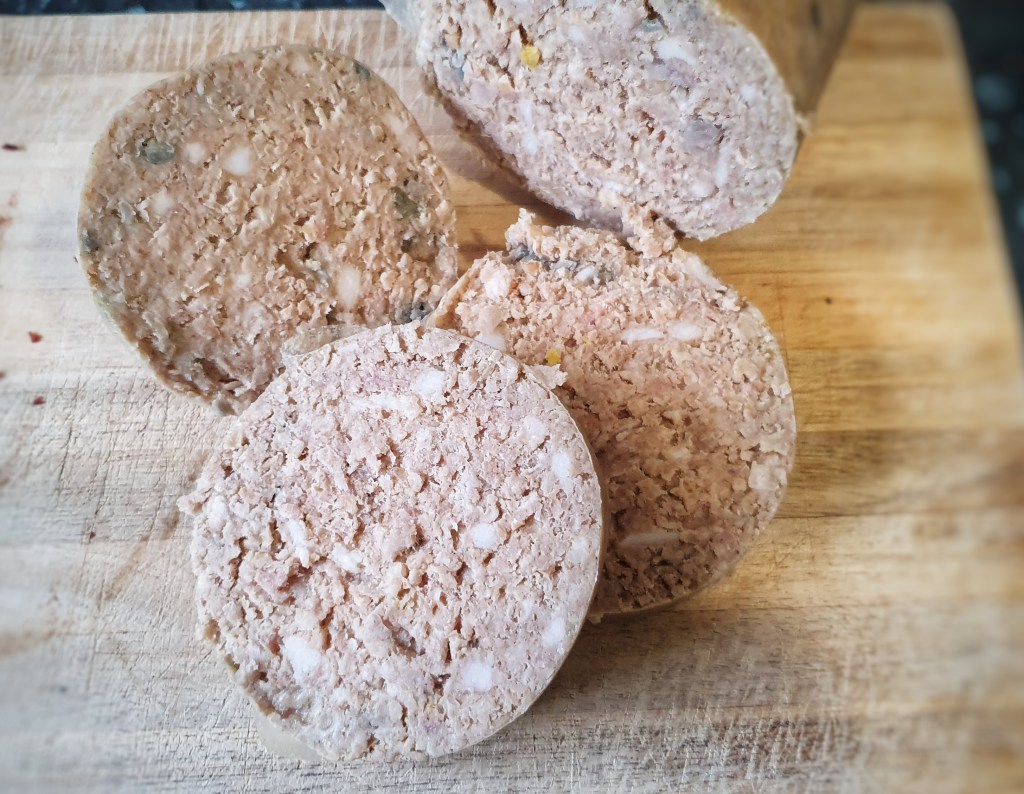
We talk about how and why they started up Fruit Pig, battling squeamishness, why it’s so difficult to make fresh blood black puddings, and serving suggestions – amongst many other things
The podcast is available on all podcast apps, aandd now YouTube. Please give it a follow, and if you can, please rate and review. If you’re not a podcasty person, you can listen via this Spotify imbed:
Some serving suggestions
One other thing we talked about was serving suggestions, and of course a slice or two of black and white pudding as part of a full English breakfast is admirable. You can go one better and have the full triple of black pud, white and haggis for a full Scottish! Personally, I believe a slice of fried bread topped with a couple of slices of fried pudding and a poached egg is the breakfast of champions.
These puddings are not just for breakfast, though. In Lancashire, a favourite way of eating black pudding is to poach it again, remove it from the water, drain, split lengthways and spread it with mustard. I have eaten it this way when visiting Bury Market. But my favourite way of eating black and white pudding in a simple way, is to serve fried slices of pudding with mashed potatoes and apple sauce – hot or cold, not too sweet. Here’s how to make a good ‘savoury’ apple sauce:
Peel, core and slice 2 medium-sized Bramley apples, and 2 tart dessert apples (e.g. Cox’s Orange Pippin) and fry in a saucepan with 60 g salted butter and a good few grinds of pepper. When the Bramleys start to soften, add 2 level tablespoons of sugar and 4 or 5 tablespoons of water. Cover and cook on medium heat, stirring occasionally, until the apples are cooked through and the Bramleys have broken down to a puree. Taste and correct seasoning. You need something still very tart to cut through the rich puddings.
Keep a lookout for a proper recipe and some of my experiments with the fresh blood, Matthew and Grant kindly sent me.
If you can, support the podcast and blogs by becoming a £3 monthly subscriber, and unlock lots of premium content, including bonus blog posts and recipes, access to the easter eggs and the secret podcast, or treat me to a one-off virtual pint or coffee: click here.
This episode was mixed and engineered by Thomas Ntinas of the Delicious Legacy podcast.
Things mentioned in today’s episode
Fruit Pig on Jamie & Jimmy’s Friday Night Feast
Fruit Pig on BBC Radio 4’s The Food Programme
Neil’s appearance on Comfortably Hungry discussing black/blood pudding
Museum of Royal Worcester project wins a British Library Food Season Award
Follow Serve it Forth on Instagram at @serveitforthfest
Podcast episodes pertinent to today’s episode
The Philosophy of Puddings with Neil Buttery, Peter Gilchrist & Lindsay Middleton:
18th Century Female Cookery Writers with The Delicious Legacy:
Neil’s books:
Before Mrs Beeton: Elizabeth Raffald, England’s Most Influential Housekeeper
Knead to Know: a History of Baking
Don’t forget, there will be postbag episodes in the future, so if you have any questions or queries about today’s episode, or indeed any episode, or have a question about the history of British food please email me at neil@britishfoodhistory.com, or leave a comment below.
Roast Turkey and Giblet Gravy
This blog post complements the recent episode of The British Food History Podcast called Turkey with Tom Copas.
If you feel inspired to order a Copas turkey, you need to get your order in by 16 December to avoid disappointment.
In the episode, we discussed the best way to roast turkey and we concluded that as long as you baste the bird and calculate the cooking time properly, it will be delicious. Tom even says that there’s no need to cover the turkey with bacon. While I agree with him, I do like the crispy bacon and the delicious, perfectly seasoned juices that come from the roasting turkey. My way of roasting turkey is very similar to how I cook a chicken.
What we didn’t discuss is the giblets! Please don’t waste them, they can be turned into lovely rich gravy when combined with the roasting juices. It’s important to get the giblet stock on about 45 minutes before the turkey goes in the oven (or you could prepare it in advance).
If you want to stuff the turkey, I suggest you stuff the neck only because an empty cavity means quicker cooking and a more succulent turkey.
Right, let’s get to it.
If you like the blogs and podcast I produce and would to start a £3 monthly subscription, or would like to treat me to virtual coffee or pint: follow this link for more information. Thank you.
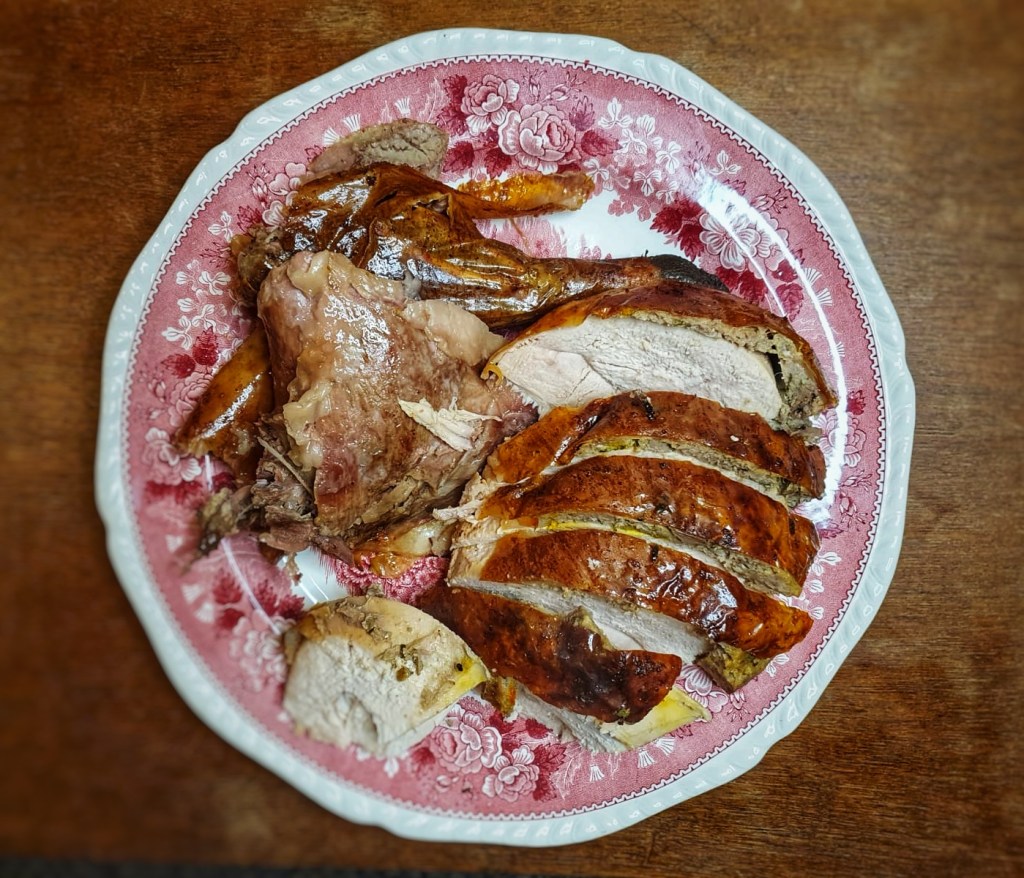

To Roast a Turkey
You don’t have to use bacon if you don’t want to, but butter is essential. It adds richness, helps the bird keep moist and gives the skin a lovely deep brown colour.
1 free-range turkey
250 g salted butter, softened
Freshly ground black pepper
Around 14 rashers of dry-cured streaky bacon (optional)
Stuffing (optional)
Halved or quartered carrots and parsnips (optional; see recipe)
As soon as you get up on Christmas morning, take the turkey out of the fridge, untruss it, and when it’s time to cook the turkey, preheat your oven to 190°C.
Sit the turkey on a board, legs facing towards you, then make a tear in the skin where the breast starts and lift the skin away from the breast. Don’t rush – you don’t want to tear the skin. Put half the butter between the skin and breast and massage it as far back as possible. If you are using stuffing, add this under the skin too and tuck the flap of neck skin underneath. If there’s not much neck skin, don’t worry, it can be secured with a skewer.
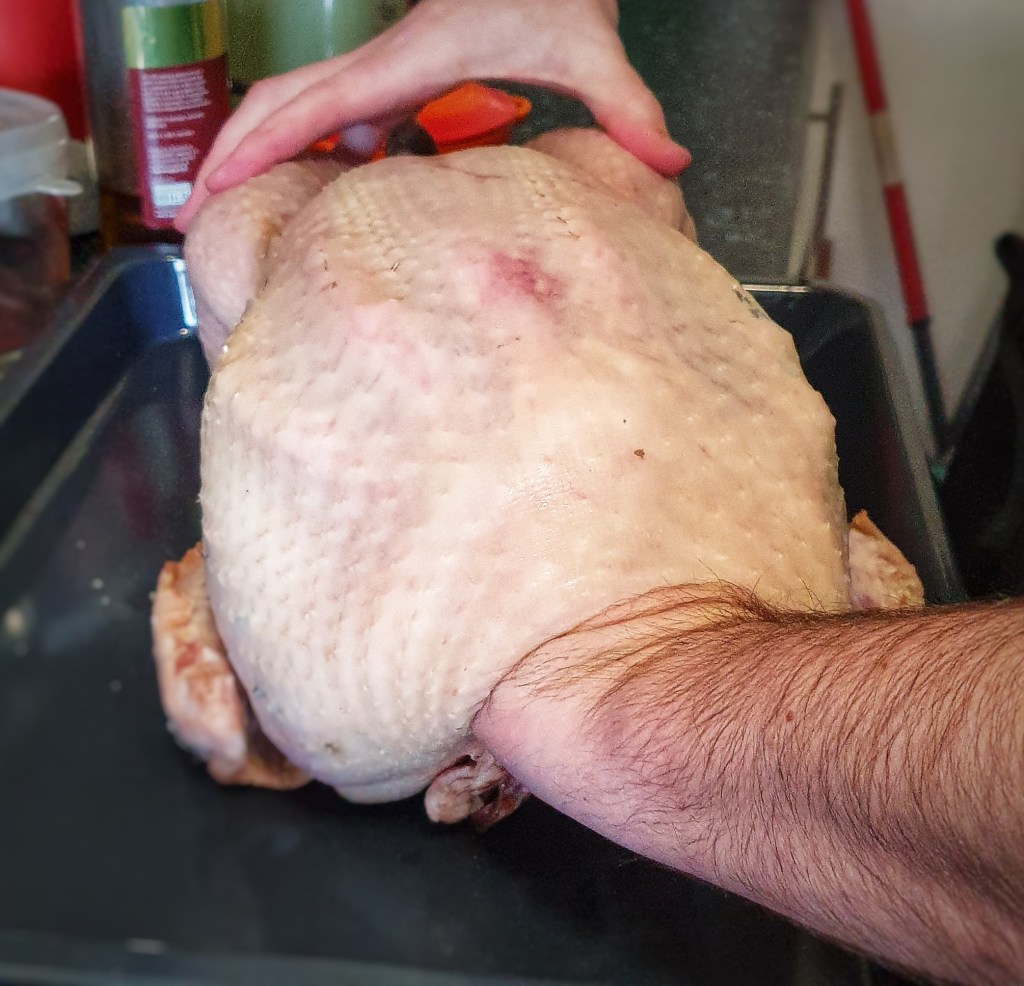
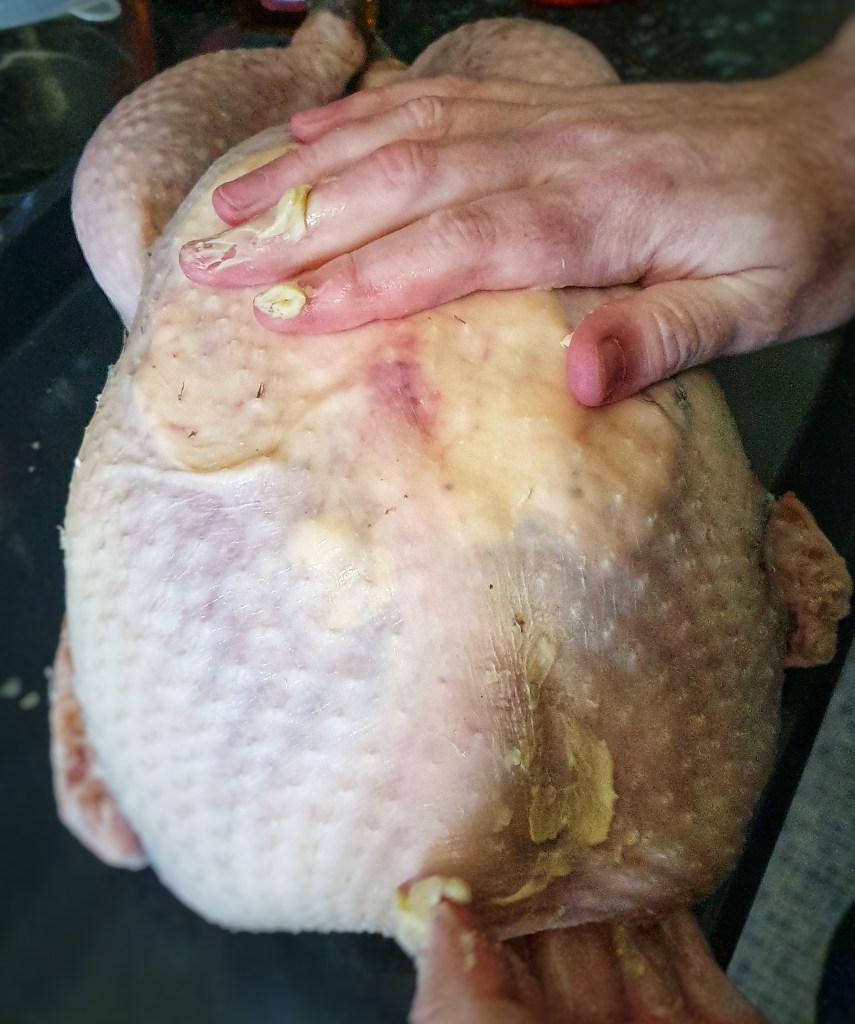
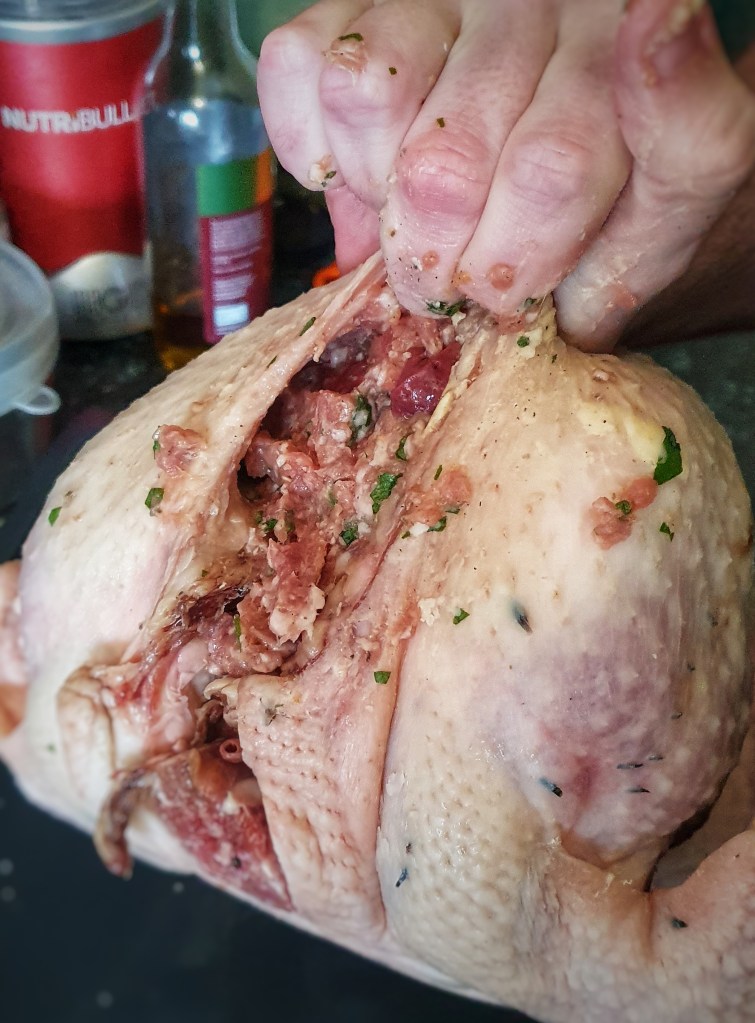
Smear the rest of the butter over the outside of the turkey and season with plenty of black pepper, then lay the bacon over, overlapping each rasher only slightly.

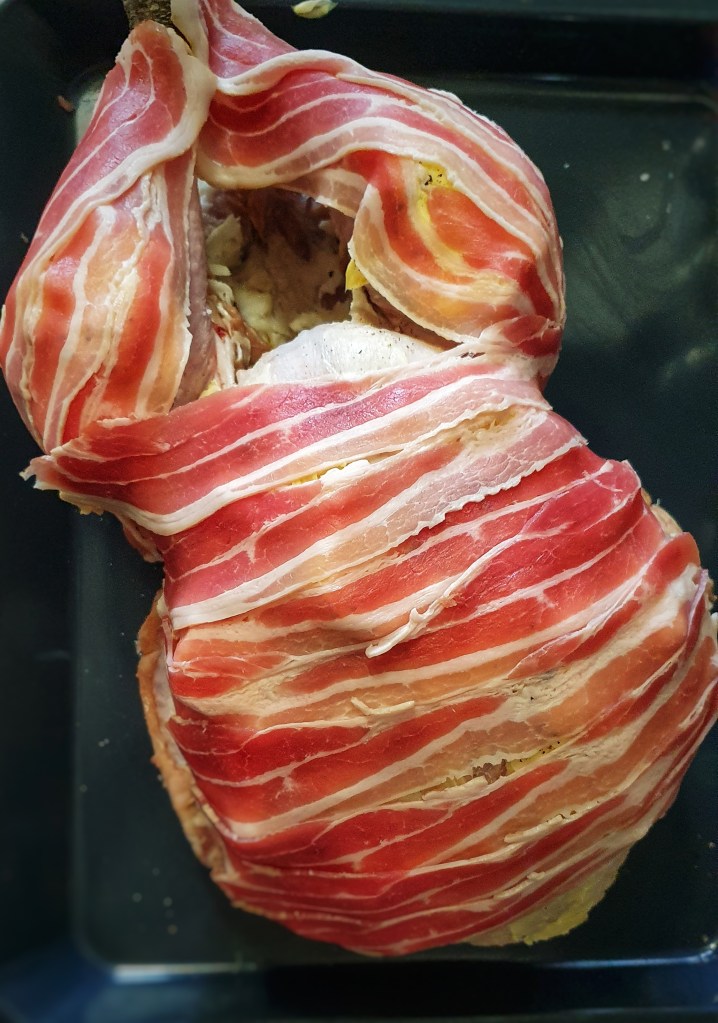
Weigh the prepared turkey and calculate the cooking time: 30 minutes per kilo. A 4.5 kilo turkey will take 2 ½ hours. If cooking for more than 3 hours, cover the legs with foil.
Sit the turkey in its roasting tin, place it in the oven, and leave it for a good 45 minutes before doing anything at all. At the 45-minute mark baste the turkey with any juices; make sure to tip any juices in the cavity into the roasting tin.
Baste every 20 minutes or so. When the bacon is very crispy, remove it and set aside.
If you like you can add some carrots and parsnips, peeled and halved or quartered to braise in the juices. It’s best to do this when there are 90 minutes to go – don’t forget to turn the veg over each time you braise.
When the time is up, you can test with a digital probe: 68°C is the temperature you are looking for. Take the turkey, place it on a carving board and cover with foil. It will happily rest for one to two hours.
When it’s time to carve, remove the legs and separate them into thighs and drumsticks. For the breast, I find the easiest way is to remove one side completely and then slice it thickly. These can be arranged on a warm serving plate, surrounded by the crisp bacon. Only cut into the second breast if the first one goes (it keeps better that way for leftover feasts).

To Make Giblet Gravy
Don’t waste or fear the giblets! The giblets are the heart, neck, gizzard and liver.[1] Use your vegetable trimmings from the veg to make the stock: though avoid brassicas like sprouts.
For the stock:
Heart, gizzard and neck
A knob of butter
Leek greens, carrot peelings, and some celery trimmings, or 2 outer stems of celery
2 cloves of garlic, lightly crushed
Herbs: bay leaves, parsley stalks, rosemary or thyme sprig tied with string
175 ml white wine
Cold water
For the gravy
Giblet stock
Pan of turkey juices
1 tbs cornflour
To make the stock, first cut up the giblets into quarters.
In a saucepan, heat the butter until foaming, add the giblets and fry over a medium-high heat until brown – about 5 minutes. Now add the vegetable trimmings, garlic and herbs and wilt them. Cook until they have picked up a tinge of brown, then add the wine. Stir and scrape any nice burnt bits from the bottom. Add water to just cover the contents, put a lid on and bring to a simmer and cook for around 3 hours, then strain through a sieve into a clean pan (or into a tub if you’re making it in advance).
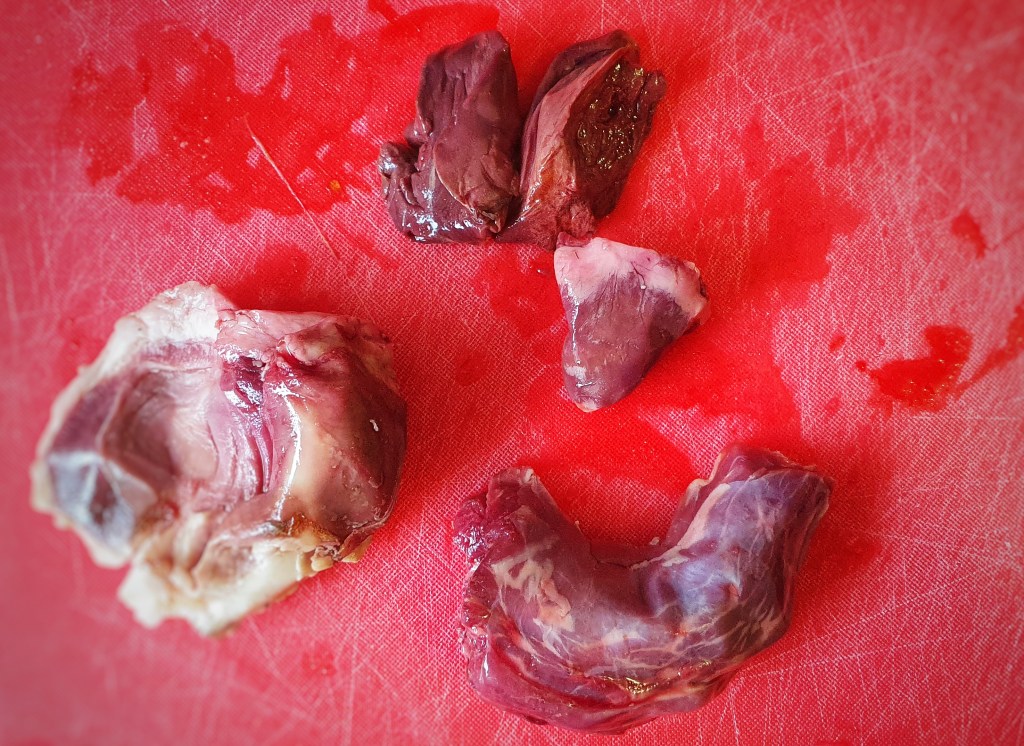
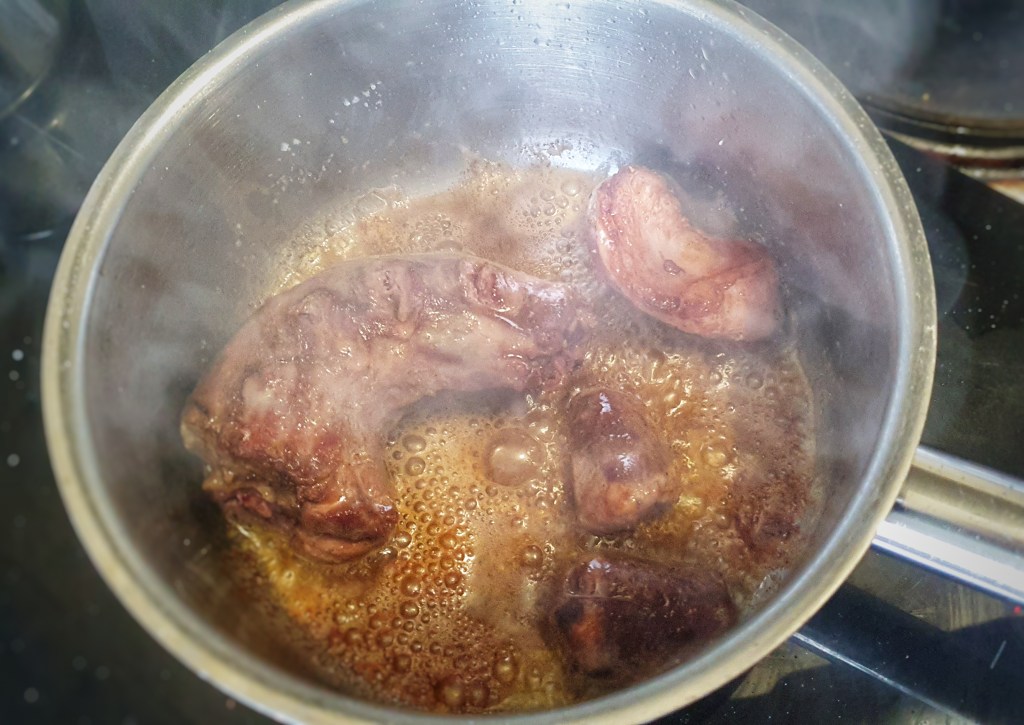

When it’s time to make the gravy, get the stock nice and hot. When the turkey is cooked and is resting on its board, pour the hot stock into the roasting tin and scrape off all the nice treacly burnt bits, then tip the whole thing back into your saucepan. Skim away most of the buttery juices.[2] Bring to a simmer and then add the cornflour which has been first slaked in a little cold water. Stir and simmer unlidded for 10 minutes.
Check the seasoning, though usually I find that the bacon and the salted butter from roasting the turkey have done it for me. Pour the gravy into a jug. You can pass it through a sieve, but I never do. Easy!
[1] Use the liver for the stuffing, or fry it and eat it on toast. You could devil it – recipe for devilling livers can be found here.
[2] But don’t throw the fat away, it can be used for frying vegetables for sauces or soup.
Edward Kidder’s Early 18th Century Mince Pies
This post complements the 2023 Christmas special of The British Food History Podcast called ‘Mince Pies’:
As promised on this year’s Christmas episode of the podcast, all about mince pies, here is my pastry recipe and method for making the shaped-mince pies in E. Kidder’s Receipts of Pastry and Cookery. It was originally published in 1721, but I used the 1740 edition of the book (here’s a link to the document). If you go to the end of the book, you will see lots of different minced pie templates, just like the ones below. The idea was that you rolled out your pastry and cut a shape out, then made pastry walls, filled them with mincemeat, placed on lid on top and baked it. Really beautiful, but fiddly-looking shapes, I’m sure you’ll agree.
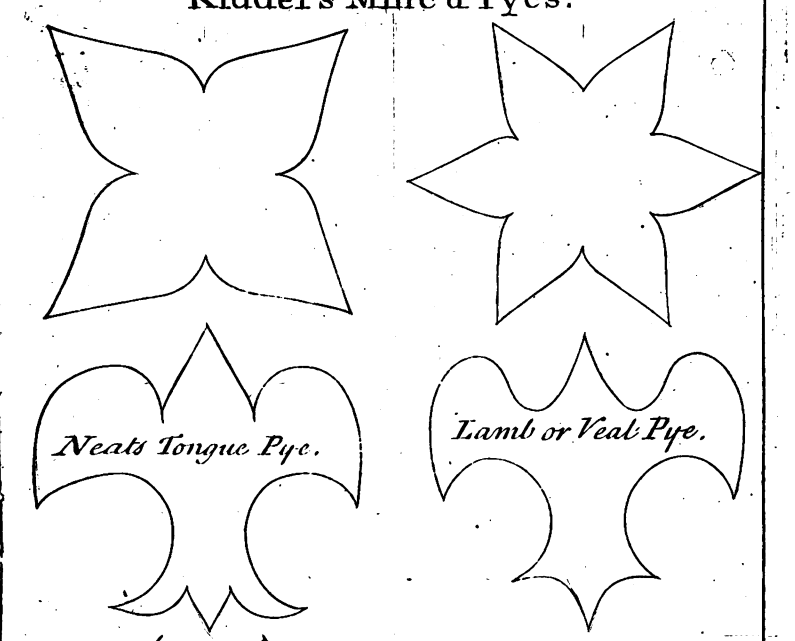

I felt a little nervous making them, so let me at this point, say a massive thank you to Ivan Day for the advice he gave me on shaping these pies. Ivan has an excellent blog with a fascinating article about mince pies (click this link to read it).
In the Christmas episode, I considered making some of the pie designs in Robert May’s The Accomplisht Cook (first published in 1660), but I found Edward’s designs much easier to extrapolate into three-dimensional pies! However, here are a few from May’s book to give you an idea of the sorts of minced pies he was making:


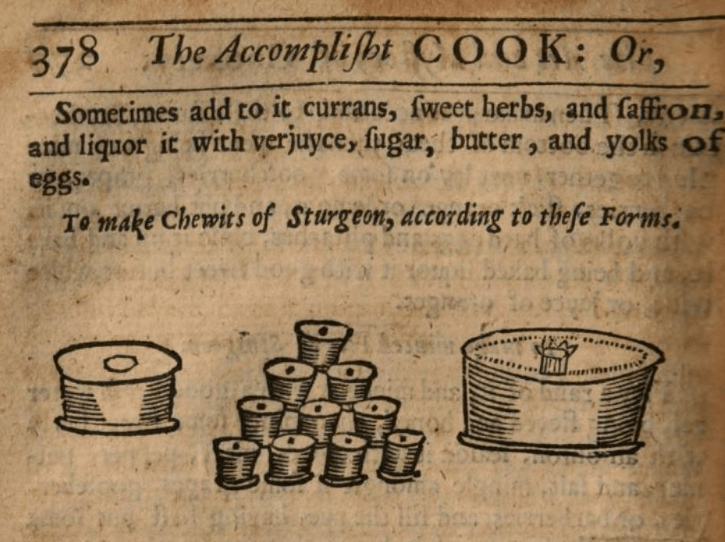
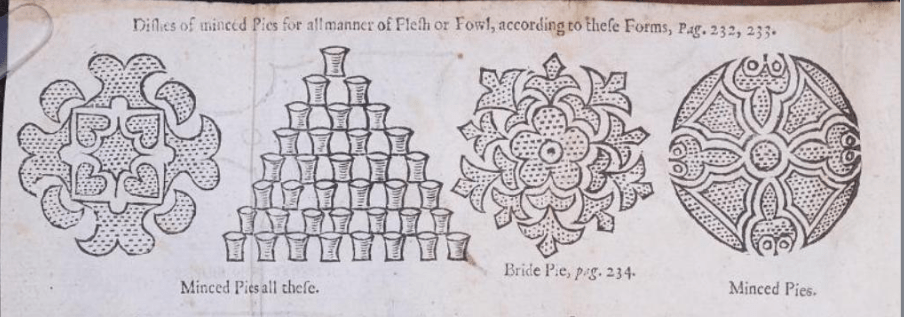
The Materials
The first thing you need to do is get organised with your templates. I simply took screenshots of the book, printed them out and cut them out. You can make them any size you like. My shapes were around 10cm wide, and I went for the ones that looked the easiest!
Then you need the correct tools for the job. I have collected over the years various pastry tools, both antique and modern. The wheels are called jiggers, which are used for cutting pastry. The antique ones usually come with a crimping tool attached, and these are used to fuse two pieces of pastry. The one I own with what looks like a flat pair of tweezers was particularly helpful for the pies I made here. I used a paring knife to cut out the shapes – the jiggers weren’t appropriate for these smaller pies.
Jiggers do come in handy for cutting out the pastry walls – essentially strips of pastry – I have a tool that’s made up of 5 jiggers on one expandable frame so you can cut several strips of the same thickness in one go.
That’s the tools of the trade, but now let’s look at our ingredients: we need mincemeat (I used the lamb mincemeat, recipe here) but you can use any you like.[1] Then we need some pastry that is mouldable (we don’t want the walls collapsing in the oven!) yet edible.
If you like the blogs and podcast I produce and would to start a £3 monthly subscription, or would like to treat me to virtual coffee or pint: follow this link for more information. Thank you.
Mouldable Hot Water Pastry
I came up with the following recipe, based on one given by Jane Grigson in English Food.[2] It’s very good for moulding, but not particularly delicious, I made a few changes and I think it’s pretty good. It is simple to make, and this was enough for 8 to 10 pies, depending upon how large your templates are (you could, of course, make one large one!)
500 g plain flour
125 g salted butter, diced
125 g lard, diced
75 ml hot water
2 tbs icing sugar
First, rub the butter into the flour until it resembles breadcrumbs. Put the lard in a saucepan and pour the hot water over it. Heat gently, but be careful – you don’t want it to boil and splutter. Stir in the icing sugar and when it is dissolved, make a well in the centre of the flour-butter mixture and pour into it three-quarters of the hot liquid. Cut the liquid in with a knife, then pour the remaining hot liquid to pour over any dry patches that remain. Once all of the water has been added, give the pastry a knead (leave it to cool a little if you need to). It should be smooth, pliable and waxy. Cover with cling film and allow to cool completely, but do not refrigerate.
Constructing the Pies
Now you can roll out a third of the pastry thinly – aim for the thickness of a pound coin, 2 to 3 millimetres – and cut out your bases. Now roll out another third into a long strip, long enough to go around the perimeter of your shapes. To do this, use a piece of string to trace around the shape. When the appropriate length, use a ruler to cut your strips at your desired thickness. I went for 2 cm, but I could have gone thicker than that, I think.
Now the fiddly bit: brush the edges of the bases with plain water and glue the sides on. Use your finger and thumb to pinch them together, and then crimp them with a crimper tool if you have one. Repeat with all of your shapes and place in the fridge for a few hours to firm up. When firm, roll out the final third of the pastry and cut out your lids.
Fill your pies with your chosen mincemeat, brush the rims of your pies with water and fix on the lids in the same way as you did the bases. Make a steam hole and place back in the fridge for 30 minutes to firm up again. Meanwhile, preheat your oven to 200°C.
If you like, brush your pies with an egg wash before you bake them for 25 minutes, or until a good golden-brown colour. If you are making large pies, turn the heat down to 175°C and cook longer: you should see or hear the filling bubbling, telling you it is ready!
Notes:
[1] Though it is best to use a low-sugar recipe, not a gloopy one from the supermarket shelves. I recommend Jane Grigson’s orange mincemeat or Mrs Beeton’s traditional mincemeat.
[2] See Oldbury Gooseberry Tarts on the other blog.
Filed under baking, Britain, cooking, Eighteenth Century, food, General, history, Recipes, Teatime, Uncategorized
Westmorland Sweet Lamb Pie
This post complements the 2023 Christmas special of The British Food History Podcast called ‘Mince Pies’:
I have written several times about mince pies and mincemeat over the years on the blog. There are my two go-to mincemeat recipes: Jane Grigson’s Orange mincemeat, and Mrs Beeton’s traditional mincemeat, along with instructions on how to make small, individual mince pies. This year, however, I wanted to make an old-fashioned sweet lamb pie, once eaten in Westmorland in the Northwest of England, a defunct county now making up parts of Cumbria and North Yorkshire. It was one of the last areas of the country to carry on putting meat in its mincemeat mixtures.[1] Like all mince pies of the past, they were not eaten only at Christmas, but much of the year, though because of the dried fruit content, they were associated with wintertime.
I was first introduced to this pie by Jane Grigson, and I made it many moons ago, for the Neil Cooks Grigson blog, I really liked it and have been meaning to revisit it.[2] These pies were not of the small individual type, but large plate pies, baked in a pie plate made of earthenware, tin or enamel.[3]
I’ve based the recipe on hers, but I did make some changes inspired by other recipes found on the Foods of England Project website.[4] The mincemeat isn’t cooked, but because of the booze and sugar content, it keeps very well. Don’t be put off by the meat content, it makes the filling succulent – and you can taste it, but this blurring of sweet and savoury is most delicious, something I have come to embrace after so many years of making historical British food.
If you like the blogs and podcast I produce and would to start a £3 monthly subscription, or would like to treat me to virtual coffee or pint: follow this link for more information. Thank you.
The filling:
This makes around 2 ¼ litres of well-packed filling, but I do intend to make two large pies at least and lots of smaller ones, so scale down if need be. It keeps for months if left somewhere dark, dry and cool; and remember mince pies are for life, not just for Christmas.
500 g lean lamb
200 g lamb or beef suet, membrane and sinew removed (packet stuff is acceptable if fresh is unavailable)
350 g apples, peeled and cored
120 g almonds
250 g each currants, raisins and sultanas
300 g soft, dark brown sugar
100 g chopped candied peel
Juice and zest of 2 oranges
120 ml dark rum
1 tsp salt
½ tsp ground black pepper
1 tsp each ground mace and cinnamon
½ freshly grated nutmeg
To make a truly ‘minced’ meat, you need to chop the meat, suet, apples and almonds quite finely. (You can, of course, use minced lamb, slivered almonds and grated apple and suet).
Mix everything together in a large bowl and pack tightly into sterilised jars.[5] Leave to mature for at least a week before using.
The pie:
These pies were made on pie plates, but you can make them in any flan or pie tin you like. For my 26 cm diameter pie plate I used the following amounts, though the pastry was quite thin, so you may want to proportion things up in line with perhaps 360 g flour. I will leave it to you to judge size and thinness. There are instructions on how to make small, individual mince pies here.
300 g plain flour
150 g butter, or 75 g each butter and lard
75 g caster or icing sugar
80-100 ml cold water
Egg wash: 1 egg beaten with ½ tsp salt
Dice the fat and rub into the flour until breadcrumbs are formed (or use the flat beater on a machine, set to slow), then add the sugar, mix, and add the water slowly mixing and stirring. Bring everything together to form a firm dough. You might not need all of the water. Knead briefly to smooth the dough, cover and then leave to rest in the fridge for around 30 minutes.
Roll out two-thirds of the dough into a round, lift and lay it over the plate neatly. Prick the base with a fork. Spoon the filling in. Again, go with your gut – do you want a thin amount or loads? I added enough to come up to the lip of my plate.
Roll the remaining third of the pastry out into a round. As it rests, wash the rim of the pie plate and place the lid on top, securing it with a crimping tool or fork prongs or with your thumb or forefinger. Cut a steam hole and brush with egg. You can sprinkle a little sugar over the top if you fancy.
Place in the fridge to firm up and preheat the oven to 200°C. When the oven has come up to heat, slide the pie onto the centre shelf and cook for around 35 minutes, or until a good golden-brown colour and you can see the filling bubble through the steam hole.
Best eaten warm with thick cream, or rum butter.
[1] Mason, L. and Brown, C. (1999) The Taste of Britain. Devon: Harper Press.
[2] Read the original post here: http://neilcooksgrigson.com/2014/01/02/388-sweet-lamb-pie-from-westmorland/
[3] Grigson, J. (1992) English Food. Third Edit. Penguin.
[4] Hughes, G., ‘North Country Sweet Pie’, The Foods of England Project. http://www.foodsofengland.co.uk/northcountrysweetpie.htm
[5] To sterilise jars, heat them in the oven for 25 minutes at 120°C. Any rubber seals – or lids with rubber seals, can be sterilised in very hot water.
To Roast a Haunch of Venison
Christmas isn’t too far away and the chances are you are probably already discussing what meats you will be roasting on the big day. Well, I am going to stick my neck out and suggest venison. Game used to be a very important part of the Christmas feasting, especially in the countryside, making an excellent centrepiece to the day’s feasting.
Regular readers will know that I love cooking with game, but it has been a while since I cooked some up for the blog. I got the opportunity to cook a nice haunch of venison because I was sent some from Farm Wilder to try out, and my gosh it was good. Apart from the meat being tender and delicious, the deer that make their venison are culled as an important part of land management in Southwest England. Without any natural predators, their numbers are increasing and pretty as they may be, they are very damaging to woodland habitats – in short, they are a menace![1]
For more information about Farm Wilder and their venison, click this link.
The important thing when buying a roasting joint is to buy as large a one as possible; large joints always roast juicier and more evenly. Bear in mind that any excess venison can be chopped and made into a hunter’s pie – essentially a shepherd’s pie but with lamb swapped for venison. I’ve suggested a 2 kg haunch but don’t worry if yours is a different weight, I have included a formula for calculating the roasting time in the method. The haunch is the equivalent of beef topside, but I think it is a much superior joint in both tenderness and flavour.
Venison is best marinated before cooking; it adds a complexity of flavour to the meat and makes it even more tender. Many recipes go into great detail about how this should be done using cooked marinades, but I think the best is also the simplest: red wine, red wine vinegar, olive oil and some herbs and spices.
Folk also make a big deal about the meat drying out in cooking (venison being a very lean meat) and there are – again – complex methods to keep the meat moist: larding it with needles or tying sheets of pork backfat or skin around it. These work, but I have found that smearing the joint with plenty of butter and covering it all with smoked streaky bacon works perfectly, adding more depth of flavour; and you get to eat some crispy bacon with your dinner.
I chose to serve my venison with potatoes and parsnips roasted in duck fat, Brussels sprouts, gravy and a fruit jelly: redcurrant is the easiest to get hold of from the shops, but quince or medlar jelly can be used too.
Serves 8:
2 kg haunch of venison
½ bottle red wine
125 ml red wine vinegar
125 ml olive oil
Around one dozen black peppercorns and juniper berries
A bunch of herbs: e.g., rosemary, thyme, marjoram or winter savoury sprigs, 3 or 4 fresh bay leaves
2 carrots, peeled and sliced
2 sticks celery, trimmed and sliced
1 leek or onion, trimmed and sliced
75 g salted butter, softened
Salt and pepper
6 to 8 rashers of smoked streaky bacon
2 tbs of redcurrant, quince or medlar jelly
2 or 3 tsp cornflour
500 ml beef stock
The day before you want to cook the venison, place it in a tub only slightly larger than the joint itself along with the wine, vinegar and olive oil. Lightly crush the spices, tie the herbs with some string and add those too. Make sure the venison is covered – or mostly covered – by the wine mixture then cover and refrigerate. Turn the meat once or twice if it is not completely submerged.
Next day, take the tub out of the fridge a few hours before you want to cook the meat, so it can come up to room temperature. Preheat your oven to 225°C. Calculate your cooking time: for rare meat roast for 15 mins per 500 g of meat plus 15 minutes; for medium 18 mins per 500 g plus 15 minutes.[2]
Now prepare the meat. Spread your vegetables in the centre of the tray and place the venison on top. Dab it dry with some kitchen paper then smear the top with the butter, season well with salt and pepper, then cover the top with the bacon, making sure each rasher overlaps the next slightly.
Ladle around half of the marinade into the tin and slide the meat into the oven. Roast for 15 minutes and then turn the heat down to 180°C. Baste the venison every 15 to 20 minutes or so, adding more marinade if it starts to dry up.
For the last 15 minutes of the cooking time, turn the heat back up to 225°C, remove the bacon, give the meat one more baste, and let it crisp up at the edges. Take the tin out, remove the meat to a board or dish and cover with kitchen foil. It will sit very happily there as you roast your potatoes and cook your veg.
Now make the gravy. Strain the contents of the tin into a jug and spoon or pour a couple of tablespoons (approximately) of the buttery olive oil layer into a saucepan. Discard the rest of the fat. Put the pan over a medium heat and stir in 2 teaspoons of cornflour. Once incorporated, cook for a minute before adding the juices. Mix to blend, before adding the beef stock, mix again and then add the remaining marinade. Cook for 10 minutes, then add the jelly and season with salt and pepper. If the gravy isn’t as thick as you’d like, slake another teaspoon of cornflour in a little cold water and stir it in. When ready, strain into a warm jug.
Remove the outer mesh covering the joint, slice and serve with the gravy, the crisp bacon rashers and extra jelly on the side.
If you like the blogs and podcast I produce and would to start a £3 monthly subscription, or would like to treat me to virtual coffee or pint: follow this link for more information. Thank you.
Notes:
[1] It is for this reason that I consider venison a vegan-friendly food: we’d have to cull them whether we ate meat or not, so we may as well.
[2] If you like your meat well done, I can’t help you.
Forgotten Foods #10: Porpoise

It seems almost inconceivable that the porpoise – a type of small dolphin – would ever have been eaten, but it was once a most high-status ingredient. Although it is obviously a mammal, in the Middle Ages it was considered a fish, and therefore it could be eaten on fast days (all of the cetaceans were ‘fish’ as were seals and beavers’ tails) and it was usually served on fish days as a substitute for venison, another very high-status meat.[1] It seems that this was a bit of a blip for Europe: for the last few centuries, as well as in antiquity, dolphins have been very much considered a ‘friend of man’, and not an animal that should be eaten, not so in the Middle Ages.[2] The word porpoise comes from the Old French words porcus and piscus: ‘pigfish’ They have also gone by the names ‘mere-swine’ and ‘seahog’[3] and were eaten at the poshest of posh feasts. When George Neville celebrated becoming Archbishop of York in 1466, he held a huge feast, inviting 2000 guests of very high rank, the fish course was made up of 608 bream and pike, and 12 porpoise and seal.[4]
There were several ways of preparing it; if fresh it was poached and served in slices. In the late 14th century manuscript Forme of Cury, it is served with frumenty.[5] Sometimes it was cooked in a broth with wine, vinegar, bread, onions and its own blood.[6] It was also salted and cooked with dried peas and beans, rather like salt pork. If tip-top fresh, ‘porpesses must be baked’. The carving term for a baked porpoise is ‘undertraunche’[7], and it is served dressed with vinegar, cinnamon and ginger.[8]
The earliest mention of a porpoise hunt occurring in the British Isles comes from the 7th century just off the Irish coast by ‘foreigners’ most probably Vikings. The 10th century manuscript Ælfric’s Colloquy does mention the hunting of dolphins[9] and when we tick into the 11th century – during the reign of Æthelred II (the Unready) – there are rolls listing fisheries in Gloucester which specialised in fishing for them. Just one porpoise is mentioned in the Domesday Book – it was paid as geld at an estate in Kent. Post-conquest, they appear more frequently in ordinances for example: 10 people were supplied for Henry III in 1256 at the Feast of St. Edward – a feast that always occurs during Lent.[10]

Kongelige Bibliotek, Gl. kgl. S. 1633 4º, Folio 60v)
One does have to wonder how much luck was needed when it came to ‘hunting’ them because the majority of them seem to have been opportunistically acquired after the poor beasts were found beached. One, therefore, also has to wonder just how fresh these porpoises were when delivered to a noble’s kitchen. I suspect that they were very quickly salted down and stored until there were ordered. There were laws laid down as to who owned the poor creatures after they were found beached; for most of the Middle Ages they were considered ‘wrecks of the sea’, so it was a case of finders’ keepers, but in the 13th and 14th centuries – the period when eating porpoises reached its peak – it was asserted that all beached porpoises belonged to the Crown.[11]
The number of porpoises consumed really drops in the Early Modern Era: Henry VIII was gifted a porpoise at Calais in 1532, and in 1575 (during the reign of Elizabeth I) one appeared for sale at Newcastle Market. After that, mentions of porpoises as food seem to dry up.[12]
If you are a historical cook, you might be wondering what you could substitute if you wanted to recreate a dish containing porpoise for a medieval menu. Historian Peter Brears has one fine suggestion: use a large piece of the freshest, firmest and largest block of tuna you can afford![13]
If you like the blogs and podcast I produce and would to start a £3 monthly subscription, or would like to treat me to virtual coffee or pint: follow this link for more information. Thank you.
[1] Brears, P. (2012). Cooking & Dining in Medieval England. Prospect Books.
[2] Davidson, A. (1999). The Oxford Companion to Food. Oxford University Press.
[3] Gardiner, M. (1997). The Exploitation of Sea-Mammals in Medieval England: Bones and their Social Context. Archaeological Journal, 154(1). https://doi.org/10.1080/00665983.1997.11078787; The Shuttleworth Family. (1858). The House and Farm Accounts of the Shuttleworths of Gawthorpe Hall, in the County of Lancaster, at Smithils and Gawthorpe From September 1582 to October 1621 · Part 4 (J. Harland, Ed.). The Chetham Society.
[4] Brears (2012)
[5] Frumenty: a whole wheat ‘risotto’, ‘messe it with porpays’, says Forme of Cury.
[6] Hieatt, C. B., & Butler, S. (1985). Curye on Inglysch: English culinary manuscripts of the fourteenth century. Oxford University Press.
[7] In the Middle Ages each animal served at table had its own carving term: so one doesn’t carve a porpoise, one ‘undertraunches’ it.
[8] Brears (2012); Furnivall, F. J. (1931). Early English Meals and Manners. Forgotten Books.
[9] It also states that whales should not be hunted: far too dangerous. Read a translation online here: https://pdf4pro.com/amp/view/aelfric-s-colloquy-translated-from-the-latin-by-2a9241.html
[10] Gardiner (1997)
[11] Ibid.
[12] The Shuttleworth Family (1858)
[13] Brears (2012)
My Best Yorkshire Pudding Recipe
Carrying on from my conversation about Yorkshire pudding with Elaine Lemm on the podcast recently, I thought I should toss my hat into the ring with my own recipe.
This post complements the episode ‘Yorkshire Pudding with Elaine Lemm’ on The British Food History Podcast:
This is a simple affair, and after some rigorous recipe testing, using fewer eggs or different mixtures of milk and water, as well as different receptacles in which to cook the batter, I think it is both excellent and fool proof. It goes by the tried-and-tested equal ratio method: i.e. equal volumes of plain flour, milk and eggs, plus a good pinch of salt, and animal fat (in my case, lard).
The pudding takes around 40 minutes to cook, the perfect amount of time to rest your roast meat before carving and serving.
In the podcast episode Elaine and I came to the conclusion that anything made in a muffin tin, isn’t really a proper Yorkshire pudding. Indeed, the consensus on my Special Postbag Edition of the podcast, cooking the batter in a tray achieves the best proportion of crispy, crunchy bits on the fringes and nice puddingy softness in the base. Listen to that episode here:
Have something to add to the debate? Please get in contact or leave a comment at the end of this post, I’m sure I shall be revisiting the subject in future postbag episodes.
Cooking in a dish that is good and thick is important for a good rise: you need something that will heat up in the oven, but also retain it when the cool batter is poured in. Don’t go for anything flimsy here: a really thick metal tin, or even better, an earthenware dish: it’s thickness and its property of retaining heat creates a pud with a fantastic rise: I got such a good one it almost hit the grill elements in my oven when put on the middle shelf! I give the dimensions of my dish in the recipe, but don’t worry if yours is slightly different; puddings like this are very forgiving with respect to dish size.
If you like the blogs and podcast I produce, please consider treating me to a virtual coffee or pint, or even a £3 monthly subscription: follow this link for more information.
Make the batter a few hours (minimum one) before you want to cook it.
Serves 6 to 8 if eaten with a roast dinner:
¾ cup (180 ml) plain flour
A good three-finger pinch of sea salt
¾ cup (180 ml) eggs
¾ cup (180 ml) milk, full fat, if possible
30 g lard, dripping or goose or duck fat
Put the flour and salt in a bowl, make a well in the centre and pour your eggs inside the well. Use a whisk to combine the eggs and flour, starting in the well, gradually mixing the flour into the eggs. This prevents lumps forming.
Once the flour and eggs are mixed, add the milk, whisking slowly at first, until it is fully mixed in, then give it a good thrashing for 30 seconds or so. Leave, covered, at room temperature until you want to cook it. If you like, pour the whole lot into a jug, for easier handling later.
When you are ready to cook your pudding, preheat the oven to 200°C.
Place the fat in your tin or dish – I used an earthenware dish of dimension 20 x 28 cm, with steeply sloping sides – and place on the centre shelf of your oven. Give the dish and fat plenty of time to get fully hot: I leave it in there for a good 25 minutes.
Now give the batter a final good whisking, quickly (but carefully) open the oven door, pull the shelf of the oven out slightly so that you can pour in the batter. The batter should sizzle and frill up in the fat.
Quickly push the shelf back into place and close the door. Do not open the door until 25 minutes have elapsed.
Bake for 25 to 30 minutes, depending upon how dark you like your risen crispy edges.
Remove and slice into squares, serving it up with your roast dinner.

